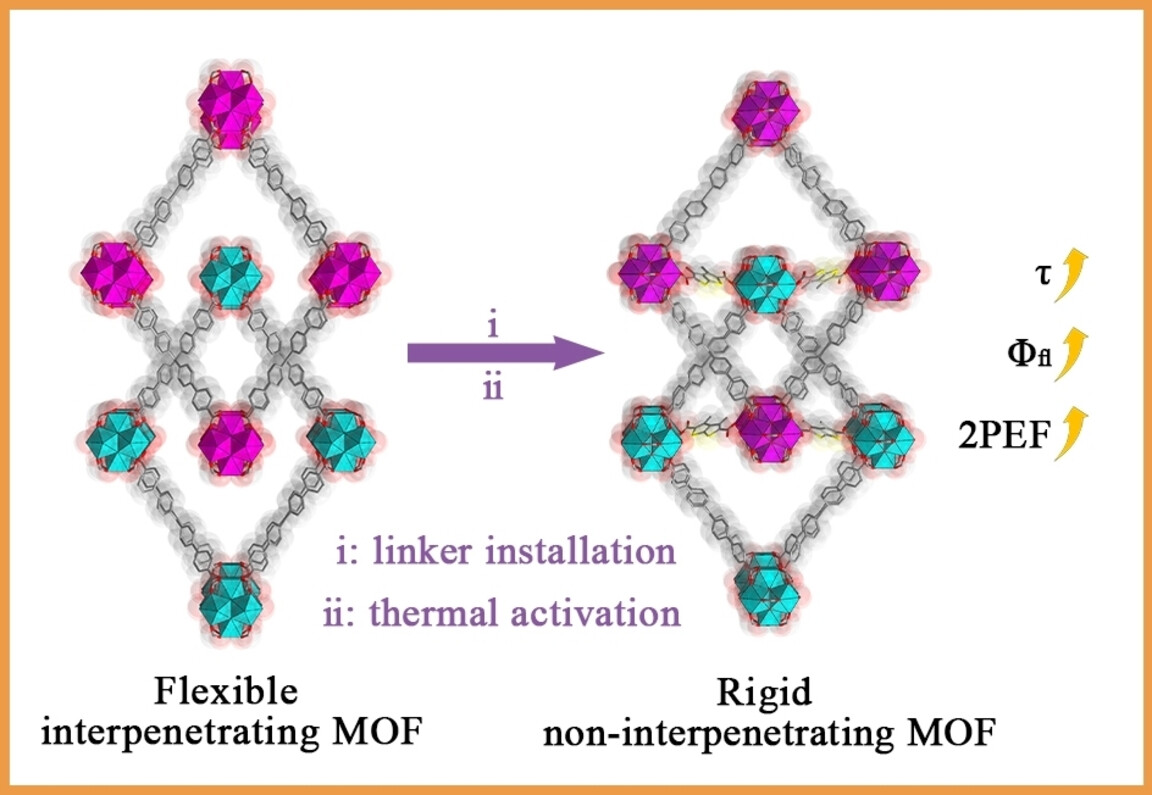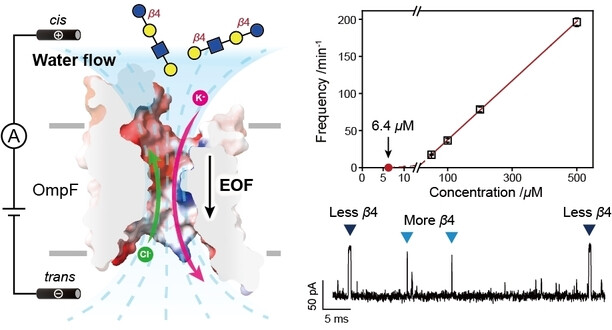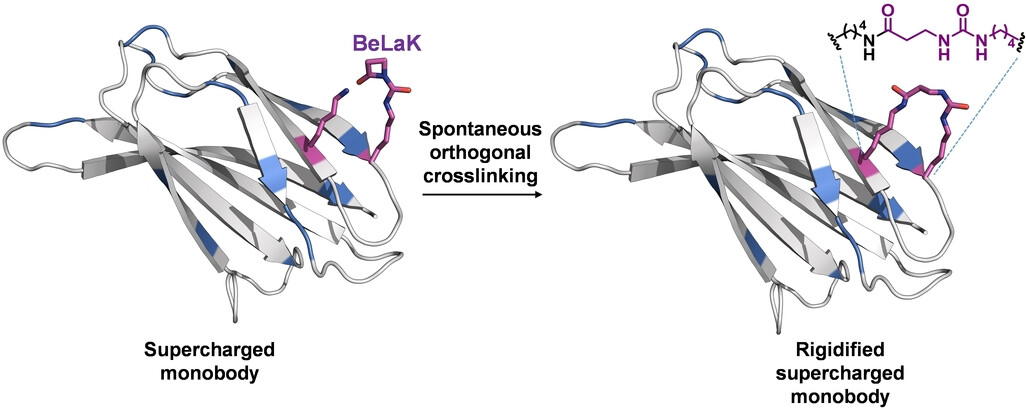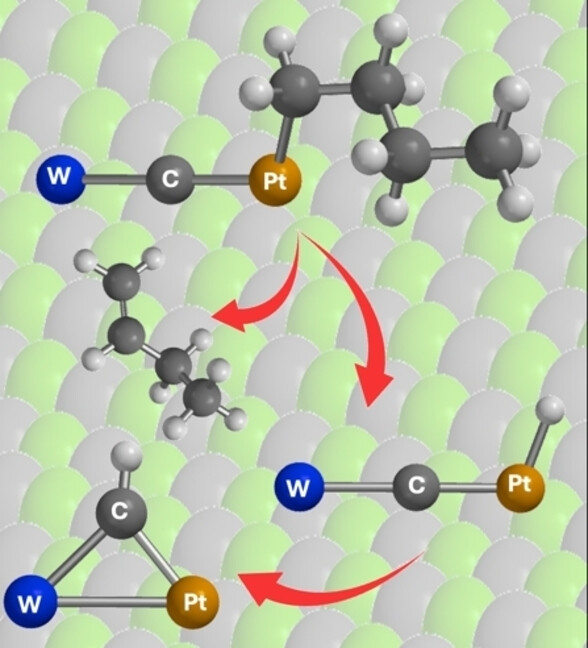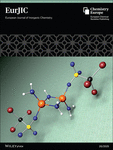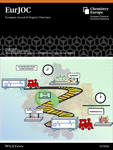Journal list menu
Export Citations
Download PDFs
Cover
Titelbild: Entschlüsselung der Polymer-Interaktionen in Biokonjugaten unterschiedlicher Architektur durch zeitaufgelöste limitierte Proteolyse mit massenspektrometrischer Analyse (Angew. Chem. 9/2025)
- First Published: 10 February 2025
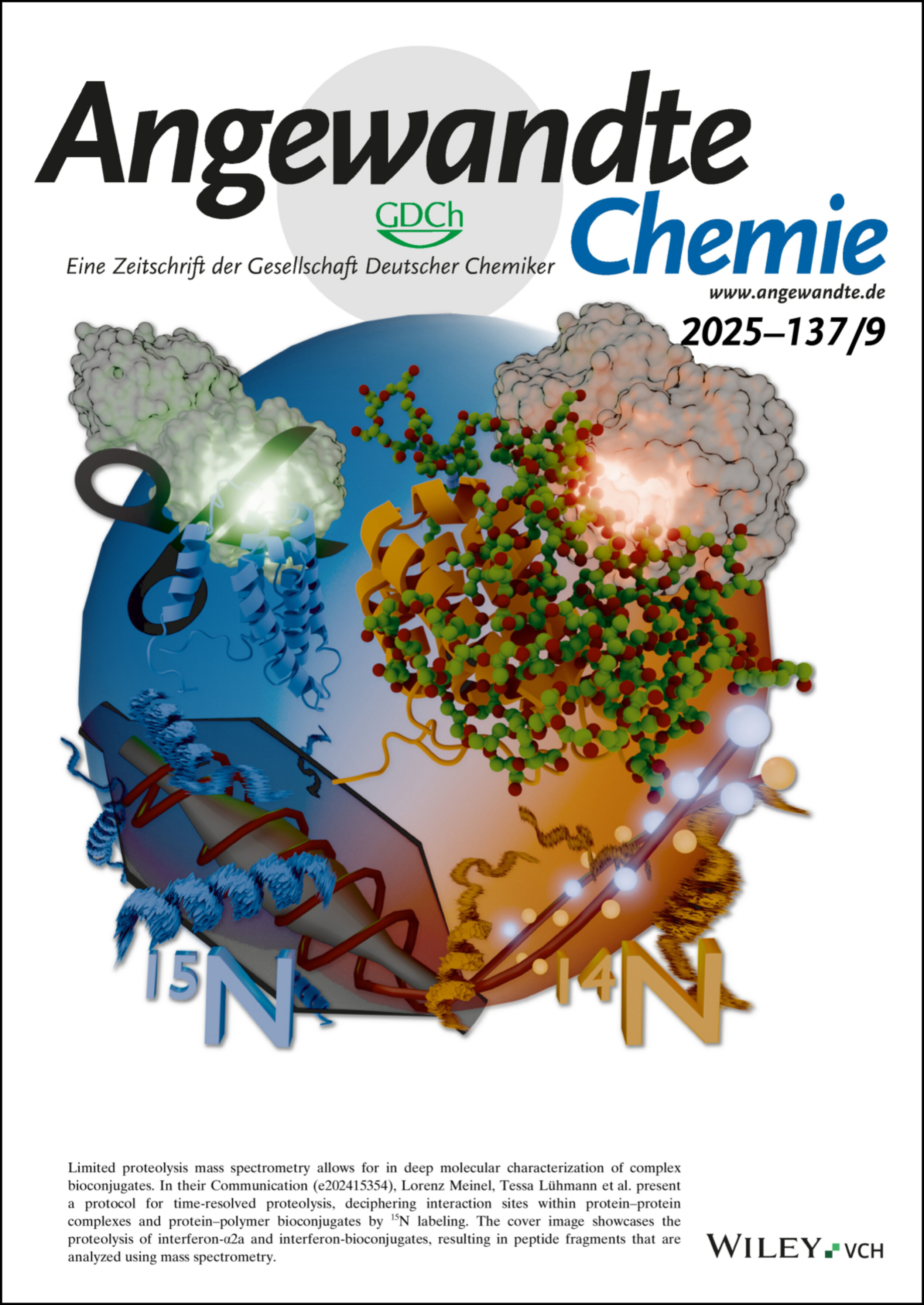
Limited proteolysis mass spectrometry allows for in deep molecular characterization of complex bioconjugates. In their Communication (e202415354), Lorenz Meinel, Tessa Lühmann et al. present a protocol for time-resolved proteolysis, deciphering interaction sites within protein–protein complexes and protein–polymer bioconjugates by 15N labeling. The cover image showcases the proteolysis of interferon-α2a and interferon-bioconjugates, resulting in peptide fragments that are analyzed using mass spectrometry.
Innentitelbild: Multiple Structural and Phase Transformations of MOF and Selective Hydrocarbon Gas Separation in its Amorphous, Glass Phase States (Angew. Chem. 9/2025)
- First Published: 10 February 2025
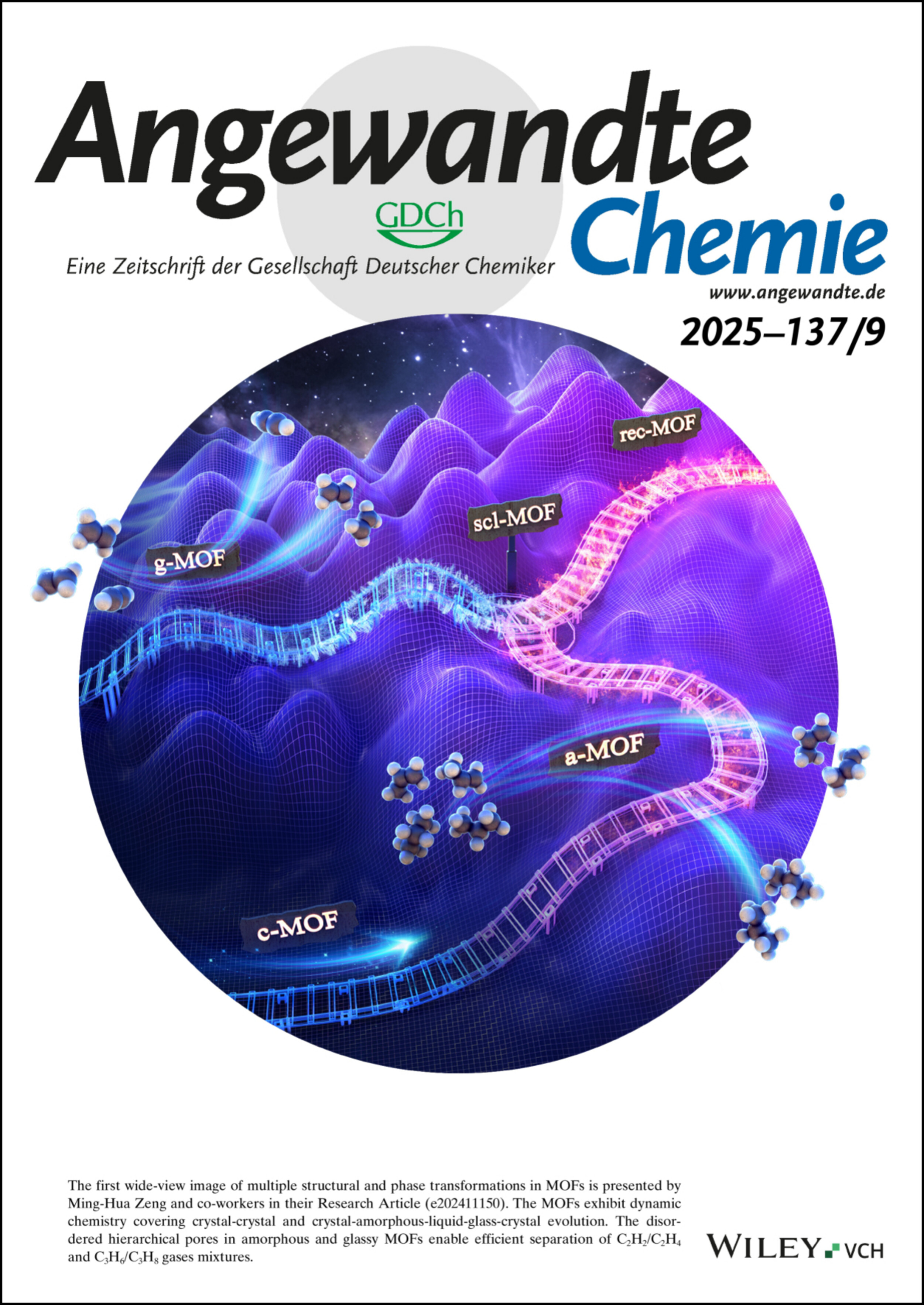
The first wide-view image of multiple structural and phase transformations in MOFs is presented by Ming-Hua Zeng and co-workers in their Research Article (e202411150). The MOFs exhibit dynamic chemistry covering crystal-crystal and crystal-amorphous-liquid-glass-crystal evolution. The disordered hierarchical pores in amorphous and glassy MOFs enable efficient separation of C2H2/C2H4 and C3H6/C3H8 gases mixtures.
Innenrücktitelbild: Scalable Atomic-Layer Tailoring of Abundant Oxide Supports Unlocks Superior Interfaces for Low-Metal-Loading Dehydrogenation (Angew. Chem. 9/2025)
- First Published: 10 February 2025
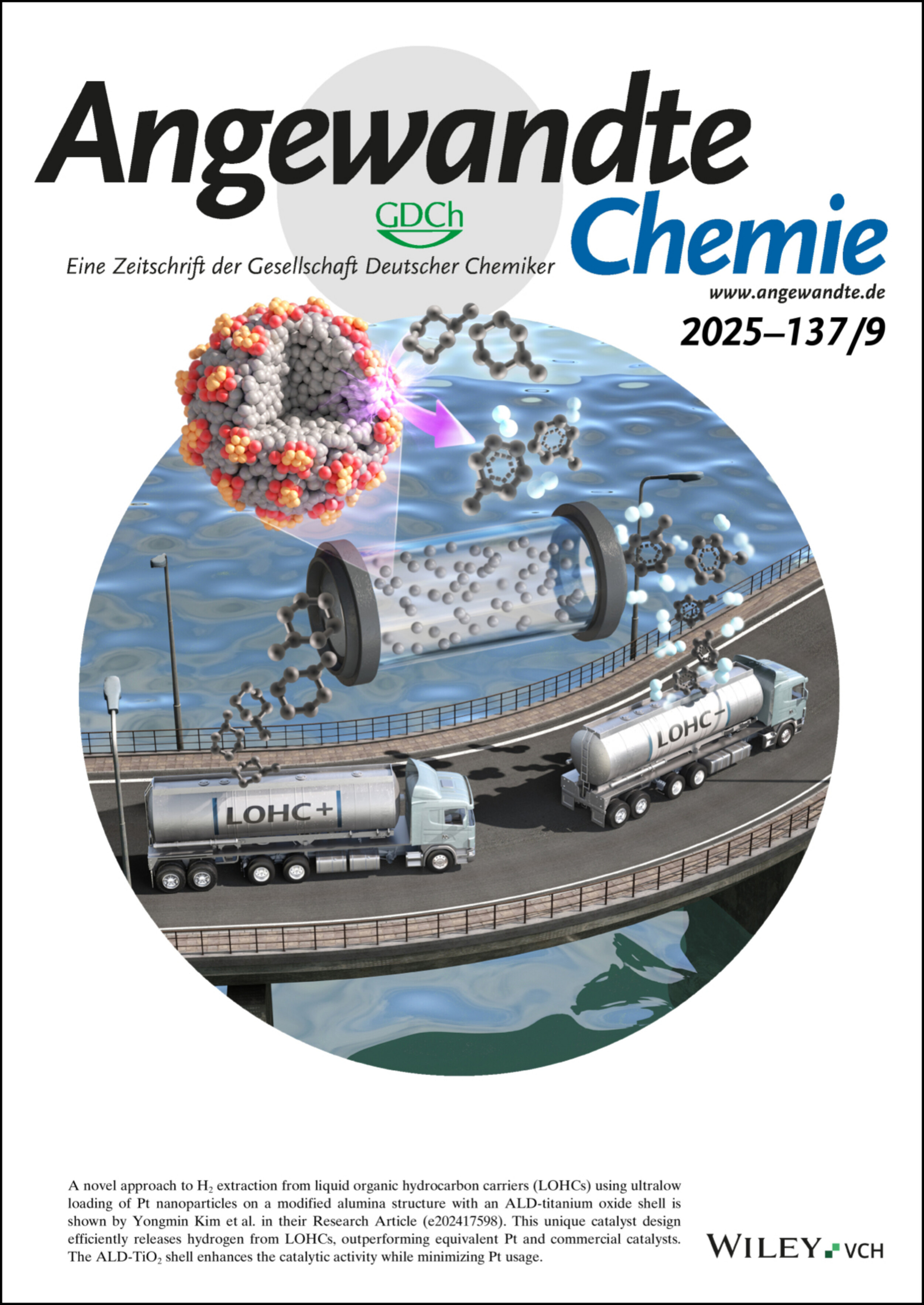
A novel approach to H2 extraction from liquid organic hydrocarbon carriers (LOHCs) using ultralow loading of Pt nanoparticles on a modified alumina structure with an ALD-titanium oxide shell is shown by Yongmin Kim et al. in their Research Article (e202417598). This unique catalyst design efficiently releases hydrogen from LOHCs, outperforming equivalent Pt and commercial catalysts. The ALD-TiO2 shell enhances the catalytic activity while minimizing Pt usage.
Rücktitelbild: Single Crystalline, Non-Stoichiometric Hydrogen-Bonded Organic Frameworks Showing Versatile Fluorescence Depending on Composition Ratios and Distributions (Angew. Chem. 9/2025)
- First Published: 10 February 2025
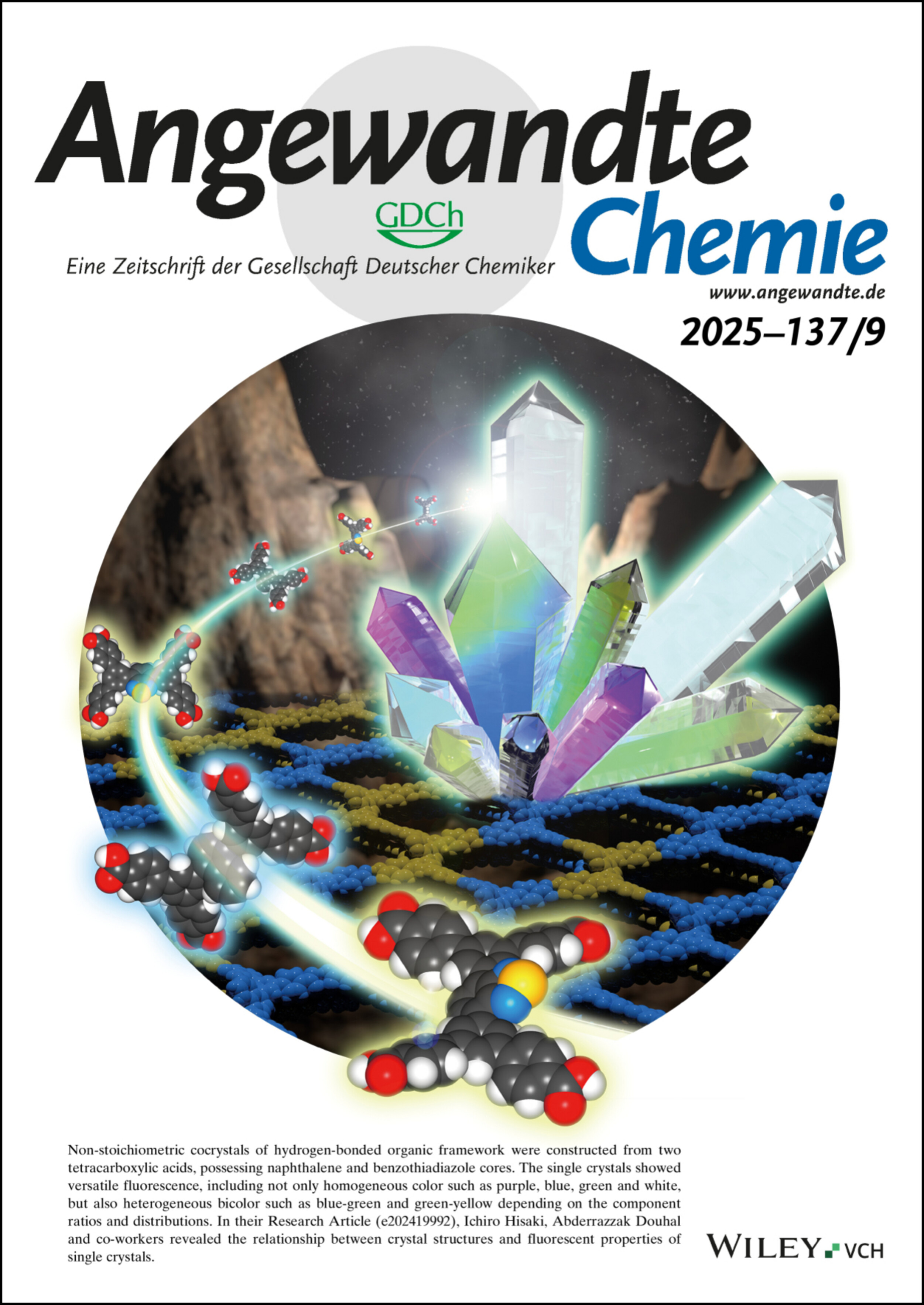
Non-stoichiometric cocrystals of hydrogen-bonded organic framework were constructed from two tetracarboxylic acids, possessing naphthalene and benzothiadiazole cores. The single crystals showed versatile fluorescence, including not only homogeneous color such as purple, blue, green and white, but also heterogeneous bicolor such as blue-green and green-yellow depending on the component ratios and distributions. In their Research Article (e202419992), Ichiro Hisaki, Abderrazzak Douhal and co-workers revealed the relationship between crystal structures and fluorescent properties of single crystals.
Frontispiz
Frontispiz: CO2 Reduction at a Borane-Modified Iron Complex: A Secondary Coordination Sphere Strategy
- First Published: 24 February 2025
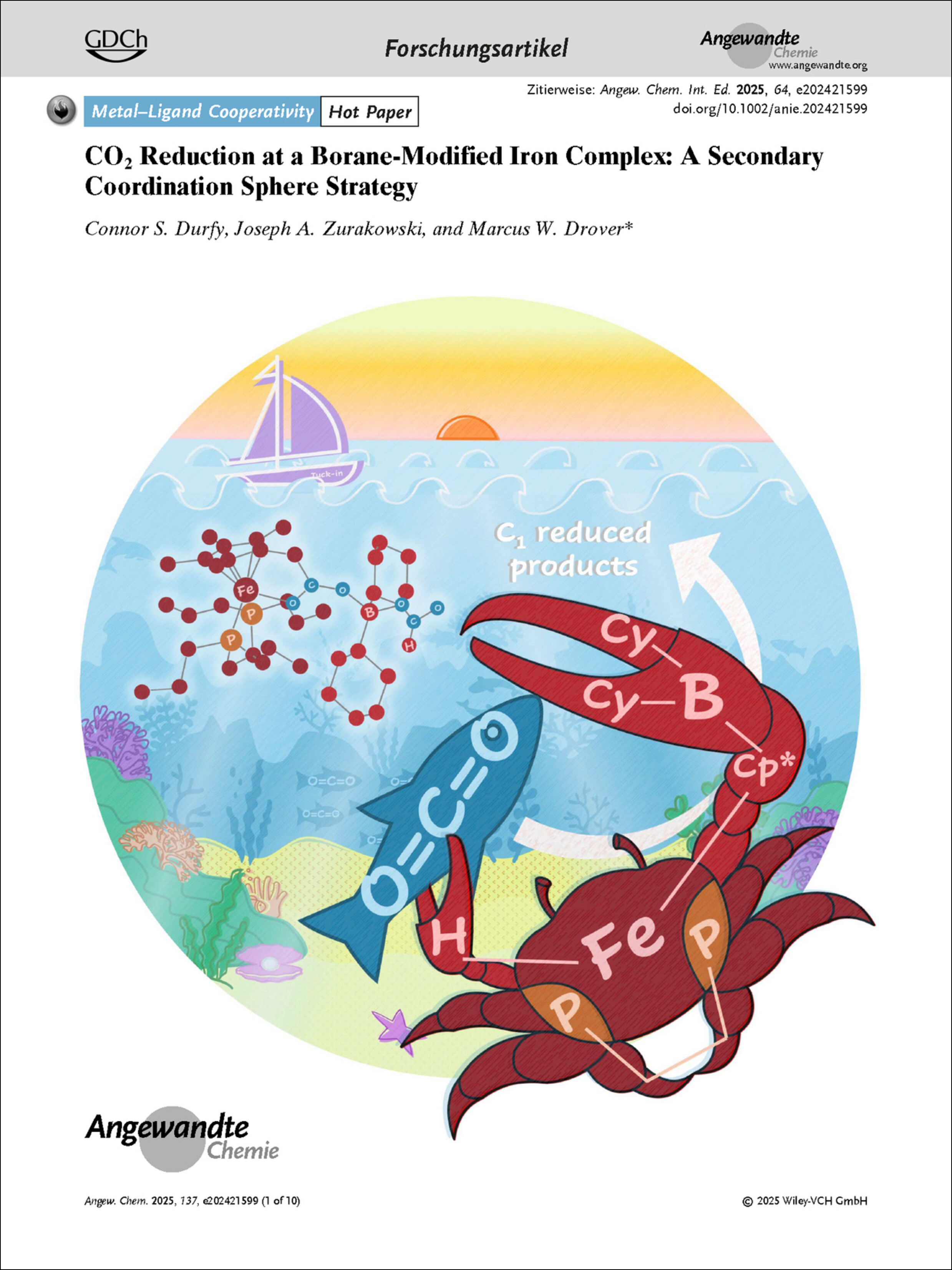
Bifunctional complex design can enable selective activation of the strong C=O bonds in CO2. Much like a fiddler crab, the {Fe-H/Cp*-BCy2} complex employed by Marcus W. Drover and co-workers in their Research Article (e202421599), features two distinct "claws". This study highlights that cooperativity between the iron hydride and pendant Lewis acidic borane is integral to facilitate the reduction of CO2 to a C1 product.
Frontispiz: Rapid N2O Formation from N2 on Water Droplet Surfaces
- First Published: 24 February 2025
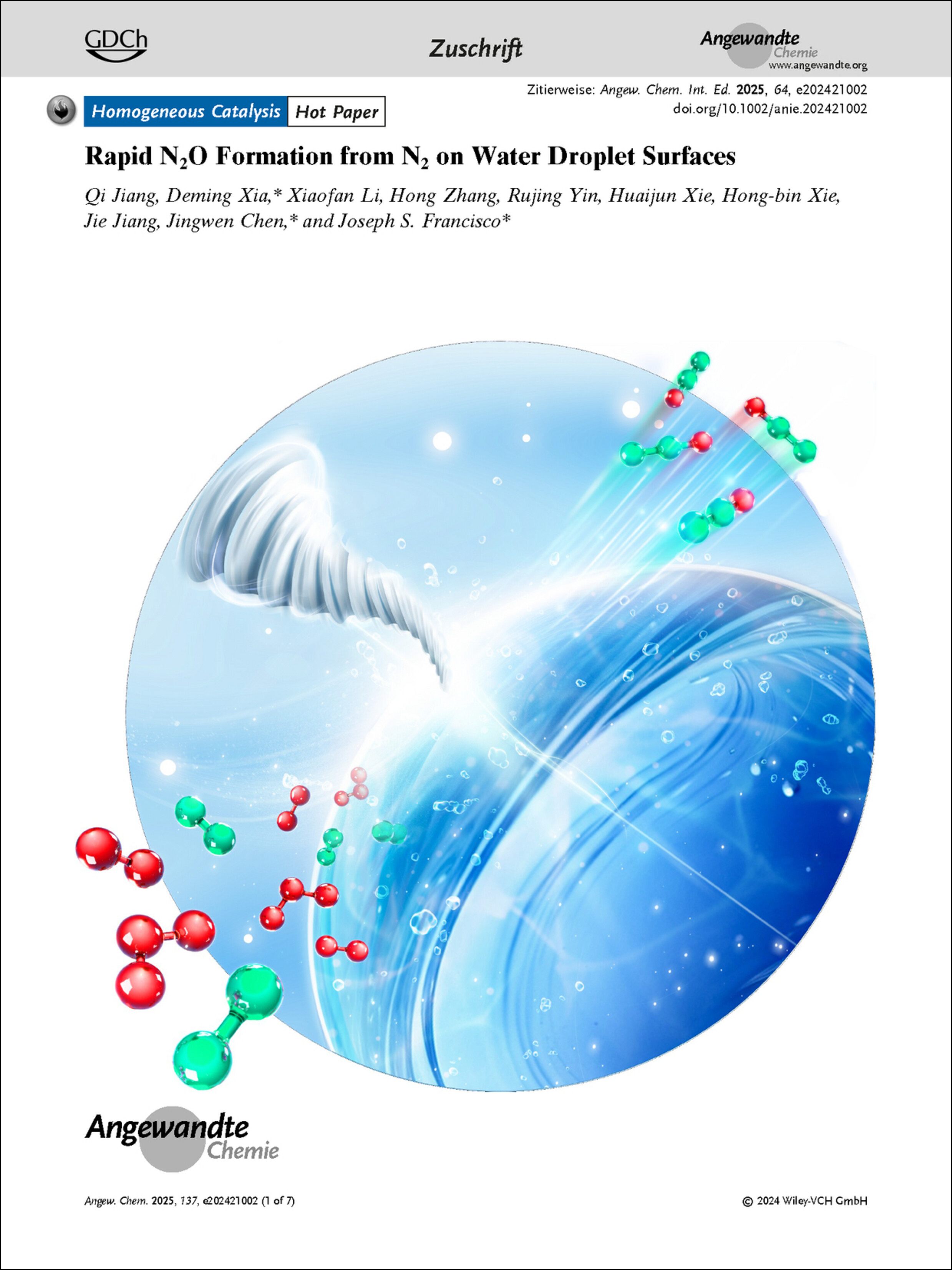
N2 has long been considered as a stable reservoir in the atmosphere. However, in their Communication (e202421002), Deming Xia, Jingwen Chen, Joseph S. Francisco et al. proposed a novel reduction-then-oxidation pathway, through which N2 can be rapidly converted to N2O by O2 and O3 on water droplet surfaces.
Introducing …
Anna Wuttig
- First Published: 05 February 2025
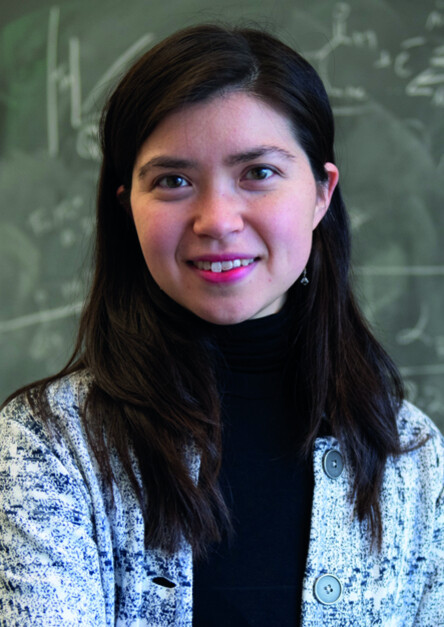
“I am most proud of my group when we follow the molecules, wherever they may take us, and, at the same time, maximize the impact of our findings… My favorite job in the lab is when seemingly disparate sets of data start to make sense in light of new thinking…” Find out more about Anna Wuttig in her Introducing… Profile.
Marcus W. Drover
- First Published: 05 February 2025

“The most rewarding aspect of being a scientist is pursuing fundamental curiosity-driven research simply because you wonder ‘what if…?’ followed by the thrill of figuring out what you've made!… I get my best ideas when I'm running on a treadmill…” Find out more about Marcus Drover in his Introducing… Profile.
Kurzaufsatz
Photochemistry
Photoacids and Photobases: Applications in Functional Dynamic Systems
- First Published: 31 January 2025
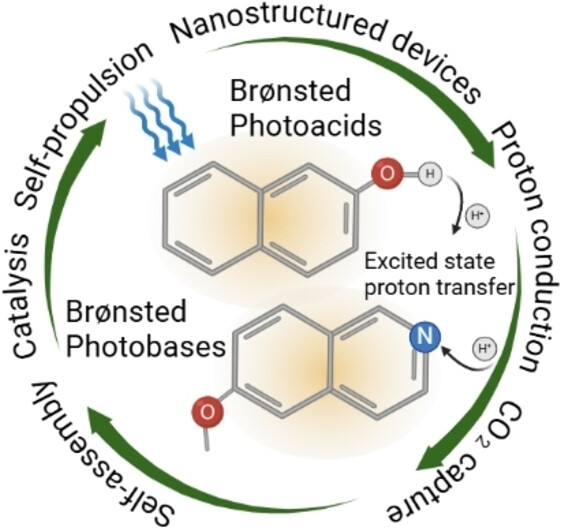
Brønsted Photoacids and Photobases represent a unique class capable of donating or accepting a proton only after excitation. Here, we review the utilization of such molecules to light-trigger the direction and amplitude of functional dynamic systems. We discuss the guidelines of how to use such molecules in various systems and give a futuristic outlook on the current technology gap for further utilization.
Aufsatz
Photoactivatable Metallodrugs
Advances in the Design of Photoactivatable Metallodrugs: Excited State Metallomics
- First Published: 13 January 2025

Fasten your seat belt! Choose lightning-speed, photoactivated journeys for complexes by selecting the metal, its oxidation state, ligands and geometry. Track complexes through excited singlet (S) states, intersystem crossing (ISC) to triplet (T) states, energy/charge-transfer, luminescence, ligand substitutions and redox reactions. Pathways to novel drugs with new mechanisms of action. Unravelling excited metallomics on the way is challenging.
Photocatalysis
Photoinduced Late-Stage Radical Decarboxylative and Deoxygenative Coupling of Complex Carboxylic Acids and Their Derivatives
- First Published: 15 January 2025

Carboxylic acids serve as versatile building blocks in organic synthesis. This review highlights recent developments and trends in the late-stage functionalization of complex carboxylic acids and their derivatives enabled by visible light photocatalysis. It discusses a variety of radical decarboxylative and deoxygenative coupling reactions, with particular emphasis on the reaction mechanisms involved, as well as potential future directions for the field.
Forschungsartikel
Metal–Ligand Cooperativity | Hot Paper
CO2 Reduction at a Borane-Modified Iron Complex: A Secondary Coordination Sphere Strategy
- First Published: 07 January 2025
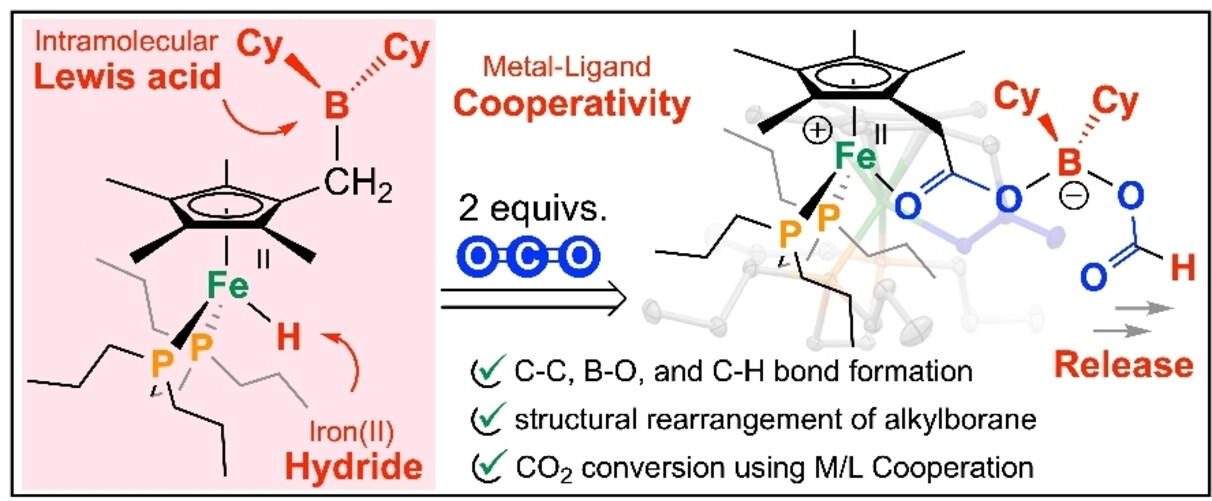
Using a bifunctional {Fe-H/Cp*-BCy2} (Cp* = C5Me5−) complex, which includes both iron-hydride and Lewis acid (borane) components, we demonstrate controlled CO2 reactivity to yield a formoxy borane-bound ferra(II)lactone [(η5-C5Me5-CH2-CO2(BCy2O2CH))FeII(diphosphine)] that incorporates two equivalents of reduced CO2. With excess HBCy2, we additionally establish catalytic dihydroboration of CO2 to produce the bis-acetal, Cy2BOCH2OBCy2 at room temperature (TON = 220 h−1).
MOF Glasses | Very Important Paper
Multiple Structural and Phase Transformations of MOF and Selective Hydrocarbon Gas Separation in its Amorphous, Glass Phase States
- First Published: 13 August 2024
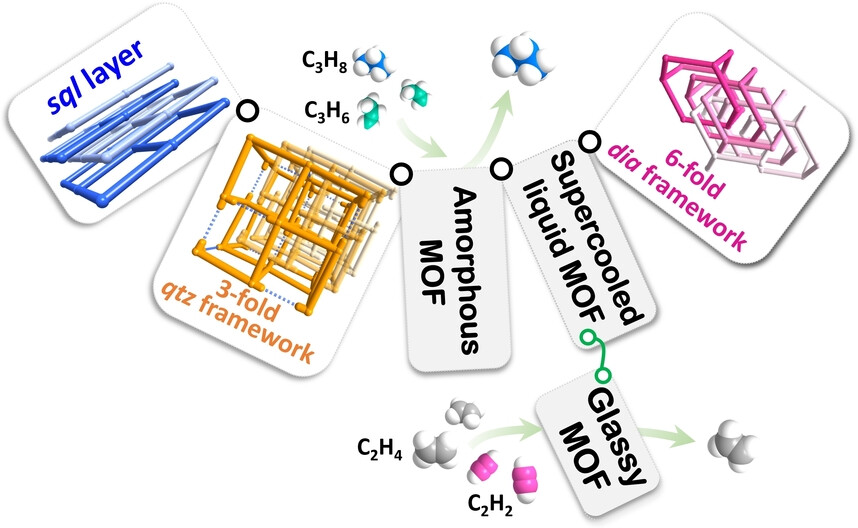
The multiple structure transformation and phase evolution within MOF provide a vivid example showing the diverse MOF dynamic chemistry under both room and high temperature. The generated disordered hierarchical pores in amorphous and glassy MOFs different to the crystalline precursor, contributes to efficient separation of either C2H2/C2H4 or C3H6/C3H8 gases mixture for the first time in breakthrough experiments.
Low-Noble-Metal Catalysts
Scalable Atomic-Layer Tailoring of Abundant Oxide Supports Unlocks Superior Interfaces for Low-Metal-Loading Dehydrogenation
- First Published: 06 November 2024
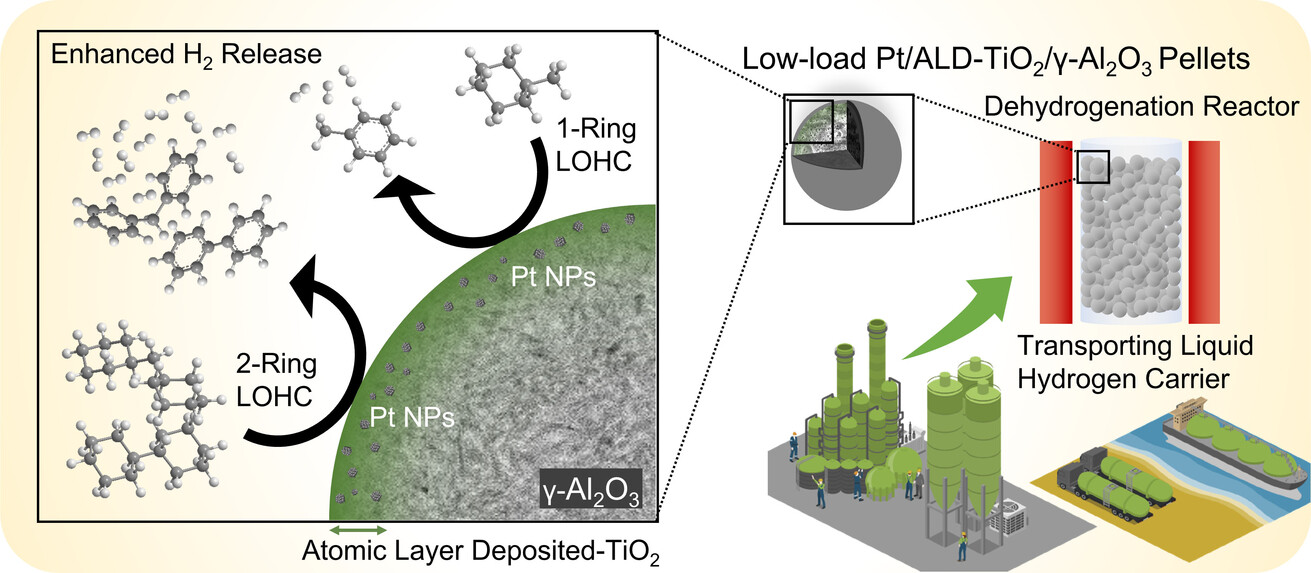
TOC illustrates an approach to hydrogen release using low-load Pt on ALD-TiO2-modified γ-Al2O3 pellets for the dehydrogenation of liquid organic hydrogen carriers (LOHC), such as methylcyclohexane and hydrogenated biphenyl/diphenylmethane mixture. The cost-efficient catalytic reactor is crucial for LOHC import scenarios, enabling effective hydrogen storage, release and transport within existing infrastructure.
Organic Materials | Very Important Paper
Single Crystalline, Non-Stoichiometric Hydrogen-Bonded Organic Frameworks Showing Versatile Fluorescence Depending on Composition Ratios and Distributions
- First Published: 25 November 2024

Homogeneous and heterogeneous fluorescence with versatile colors were achieved on single crystals of non-stoichiometrically mixed bicomponent hydrogen-bonded organic frameworks with permanent porosity. Focused synchrotron X-ray diffraction analysis and microscopic fluorescence spectroscopy on single crystals reveal structure and property relationship.
Porous Materials | Very Important Paper
Anion-π Interactions on Functionalized Porous Aromatic Cages for Gold Recovery from Complex Aqueous with High Capacity
- First Published: 18 January 2025
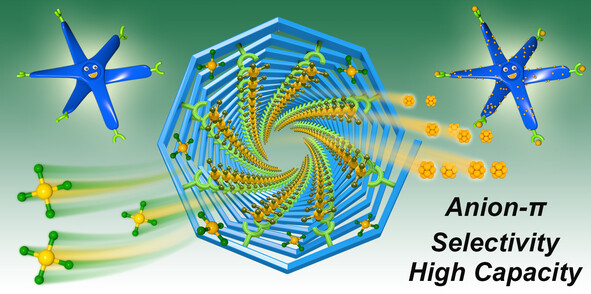
Preparation of a thiophene-modified aromatic porous organic cage (T-PAC) with high stability for efficient high-capacity gold recovery. It's also used to selectively recover gold from a variety of complex aqueous solutions in a stable and efficient manner. The theoretical calculations and dedicated experiments suggest that anion-π interactions between the [AuCl4]− and TFP fractions on T-PAC cooperated with S/N boning and redox effects play the decisive role for the highly efficient gold-recovery performance.
Protein Switches
Lanthanide-Controlled Protein Switches: Development and In Vitro and In Vivo Applications
- First Published: 24 January 2025
Nanoparticles | Very Important Paper
Autocatalytic Nucleation and Self-Assembly of Inorganic Nanoparticles into Complex Biosimilar Networks
- First Published: 12 December 2024
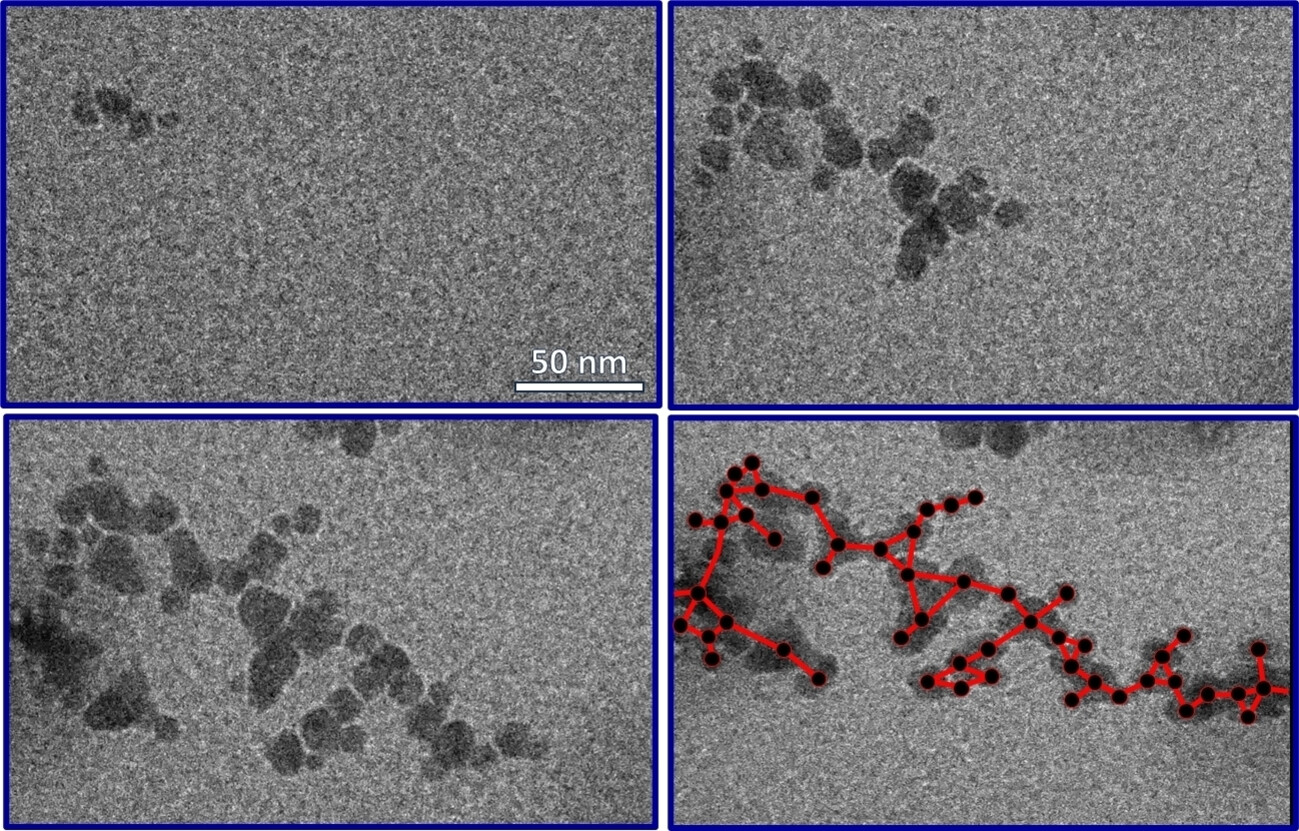
Silver nanoparticles multiply via autocatalytic nucleation. They also subsequently self-assemble into percolating chains via spatially restricted attachment. Structural analysis using graph theory (GT) reveals biomimetic organizational patterns akin to those found in biofilms. GT descriptors suggest a fundamental similarity in the mechanisms driving the emergence of complexity in both biological and abiological systems.
Covalent Organic Frameworks | Hot Paper
Constructing Donor-Acceptor Covalent Organic Frameworks for Highly Efficient H2O2 Photosynthesis Coupled with Oxidative Organic Transformations
- First Published: 19 September 2024
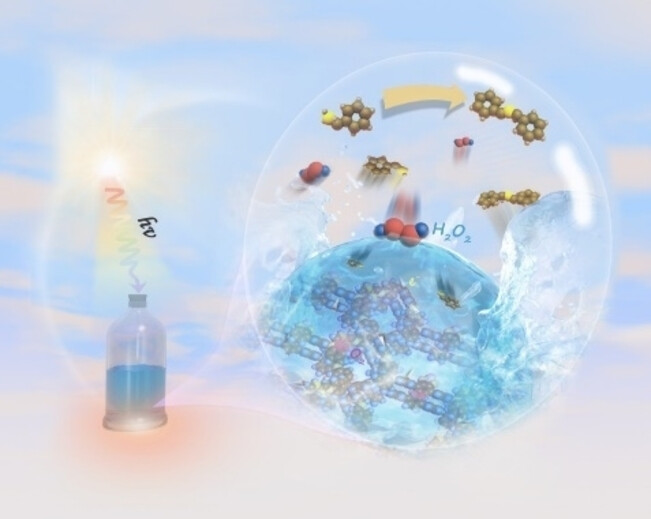
We have developed a series of donor-acceptor covalent organic frameworks (COFs) that demonstrate exceptional efficiency in H2O2 photosynthesis, coupled with the selective oxidation of organic molecules. These COFs have set a new benchmark for H2O2 production, achieving one of the highest performances reported to date. Additionally, they exhibit remarkable selectivity and yield in the oxidation of various organic substrates. This work represents a significant breakthrough in the development of COF-based photocatalytic platforms for dual-function co-production systems.
Oxygen Evolution
Cation Migration-Induced Lattice Oxygen Oxidation in Spinel Oxide for Superior Oxygen Evolution Reaction
- First Published: 10 November 2024
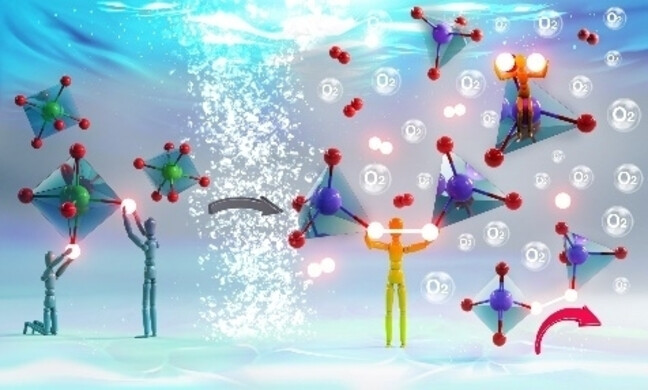
Spinel oxide, Fe0.3Co0.9Cr1.8O4 with active lattice oxygen is developed by high-throughput methods. The lattice oxygen activation is facilitated by Cr oxidation (Cr3+→Cr6+), accompanied by cation migration from octahedral to tetrahedral sites. This geometric conversion generates oxygen non-bonding states essential for lattice oxygen oxidation. Oxidized oxygen species are stabilized through dimerization with CrO4 tetrahedra (d0 Cr6+). The oxide demonstrates high activity and stability at high current densities.
Perowskit-Photovoltaik
Aryl-Acetylen-Schichthybrid-Perowskite in der Photovoltaik
- First Published: 11 January 2025
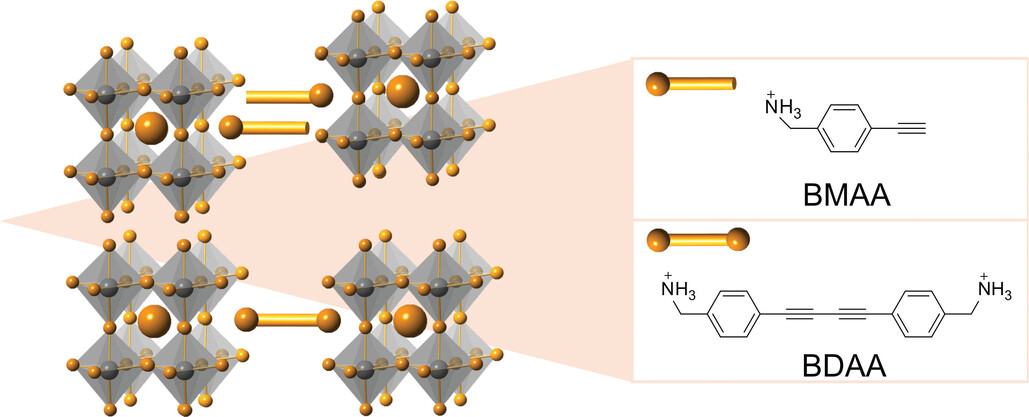
Wir demonstrieren die Fähigkeit, Zugang zu Ruddlesden-Popper- und Dion-Jacobson-2D-Perowskiten zu erhalten, die organische Spacer-Kationen auf Aryl-Acetylenbasis enthalten. Wir bewerten ihre einzigartigen opto(elektro)ionischen Eigenschaften durch eine Kombination von Techniken und verwenden sie in gemischtdimensionalen Perowskit-Solarzellen, die überlegene Leistungen und eine verbesserte Betriebsstabilität aufweisen und den Weg für Multifunktionalität in geschichteten Hybridmaterialien und deren Anwendung ebnen
Supramolecular Polymers | Hot Paper
Cu(I)-Induced G-Quartets: Robust Supramolecular Polymers Exhibiting Heating-Induced Aqueous Phase Transitions Into Gel or Precipitate
- First Published: 20 January 2025
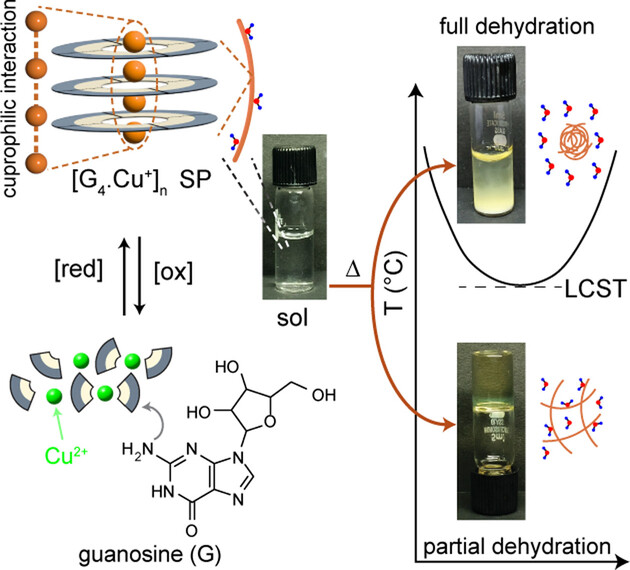
Guided by Cu+, guanosine (G) forms robust, thermoset, and redox-responsive G-quadruplex (G4.Cu+) supramolecular polymers (SPs) through unique metallophilic interactions, π–π stacking, and hydrophobic forces. Interestingly, these SPs undergo aqueous phase transitions into a hydrogel via slow dehydration-driven crosslinking below the cloud temperature (Tcp) and fast, complete dehydration into a solid precipitate above Tcp, exhibiting LCST behavior.
NMR Spectroscopy
Optimization of Structure-Guided Development of Chemical Probes for the Pseudoknot RNA of the Frameshift Element in SARS-CoV-2
- First Published: 29 January 2025

The SARS-CoV-2 frameshift element pseudoknot plays a crucial role in viral replication. Using various techniques, especially NMR spectroscopy and in vitro frameshift assays, we have developed and optimized chemical probes that serve as fundamental structures for potential inhibitors targeting viral RNAs.
Analytical Chemistry
Dynamic, Single-cell Monitoring of RNA Modifications Response to Viral Infection Using a Genetically Encoded Live-cell RNA Methylation Sensor
- First Published: 23 January 2025
Solid-State Electrolytes | Hot Paper
Nanocrystals with Aggregate Anionic Structure Enable Ion Transport Decoupling of Chain Segment Movement in Poly(ethylene oxide) Electrolytes
- First Published: 30 January 2025
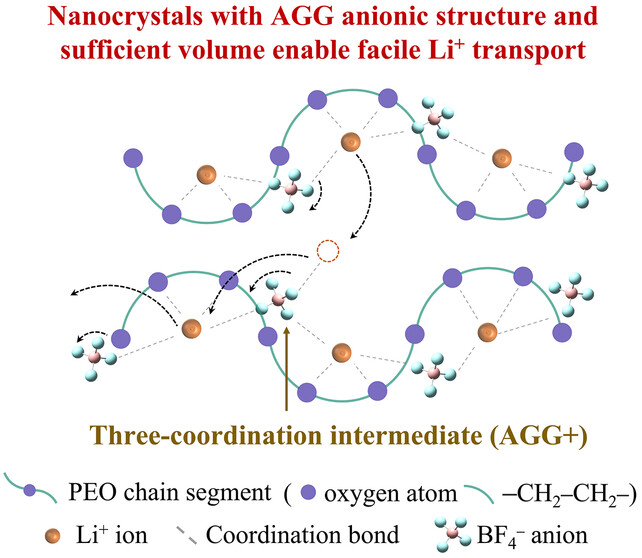
Unlike classical poly(ethylene oxide) (PEO) electrolytes, single ion conductors, and crystalline polymers, this work discovered a novel ion transport mechanism mediated by PEO3: LiBF4 nanocrystals with aggregate anionic structure, which decouples the movement of PEO segments. The ultra-thin PEO/LiBF4 electrolyte exhibits balanced ion conductivity, Li+ transference number, and mechanical strength, extending the life of all-solid-state batteries.
Antibakterielle Nanogele
pH-responsive Polyglycerol-Nanogele zur Behandlung von Parodontitis durch antibakterielle und pro-angiogenetische Wirkung
- First Published: 19 January 2025

Wir präsentieren hier einen bifunktionellen Nanogel-Komplex, der mit dem antimikrobiellen Wirkstoff Triclosan (TCS) und dem pro-angiogenetischen Wirkstoff Deferoxamin (DFO) ausgestattet ist, um mikrobielle Pathogene zu bekämpfen und die Geweberegeneration zu fördern. Durch den synergistischen Effekt von TCS und DFO zeigt der NG-TCS-DFO-Komplex eine signifikante Regeneration des Knochengewebes und eine beschleunigte Heilung der Parodontitis in vivo.
Hydroformilation | Hot Paper
A Highly Dispersed Heterogeneous Cobalt Catalyst for Efficient Domino Hydroformylation Reductive Amination of Olefins
- First Published: 29 January 2025

A highly dispersed Co−N/C catalyst has been developed for the efficient hydroaminomethylation of alkenes using CO and H2. This heterogeneous catalyst enables the synthesis of a broad range of secondary and tertiary amines, including pharmaceutically relevant molecules. The catalyst shows excellent activity, reusability, and scale-up potential, offering a green and cost-effective alternative to noble metal catalysts for amine synthesis.
Proton Exchange Membrane Fuel Cells
Converting Fe−N−C Single-atom Catalyst to a New FeNxSey Cluster Catalyst for Proton-exchange Membrane Fuel Cells
- First Published: 21 January 2025
Molecular Dynamics | Hot Paper
Harnessing Multi-Center-2-Electron Bonds for Carbene Metal-Hydride Nanocluster Catalysis
- First Published: 16 January 2025
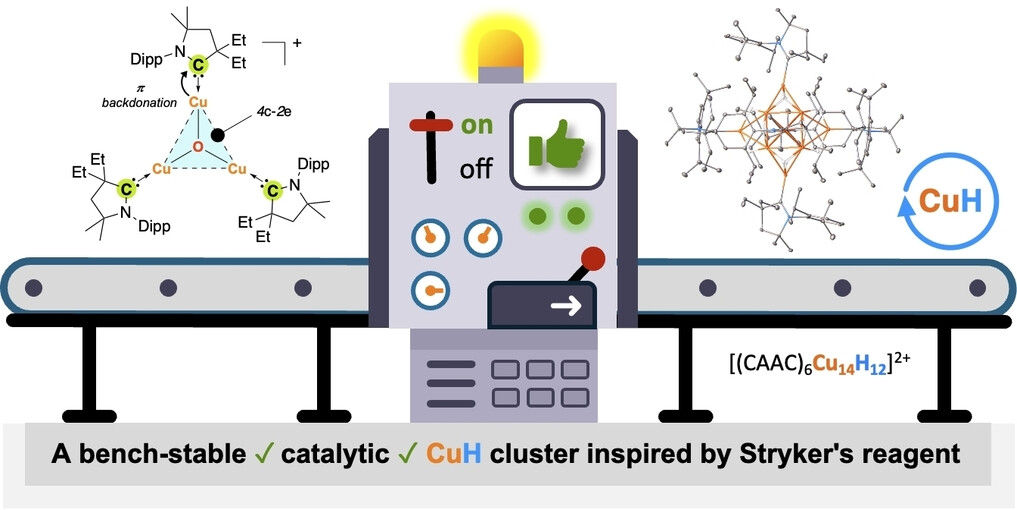
A bottom-up approach leveraging preexisting m-center-n-electron (mc-ne) bonds enables the synthesis of a highly stable cyclic(alkyl)amino carbene (CAAC) copper-hydride nanocluster, [(CAAC)6Cu14H12][OTf]2. With superior stability to Stryker's reagent, DFT calculations attribute this stability to hydride-to-ligand backbonding with π-accepting carbenes. This bench-stable cluster serves as an efficient and selective copper-hydride pre-catalyst in several catalytic applications.
Supramolecular Chemistry
Polymer Ligands with Multi-Nitrogen Heterocyclic Carbenes for Enhanced Stability and Reactivity in Nanoparticle Surface Functionalization
- First Published: 26 January 2025
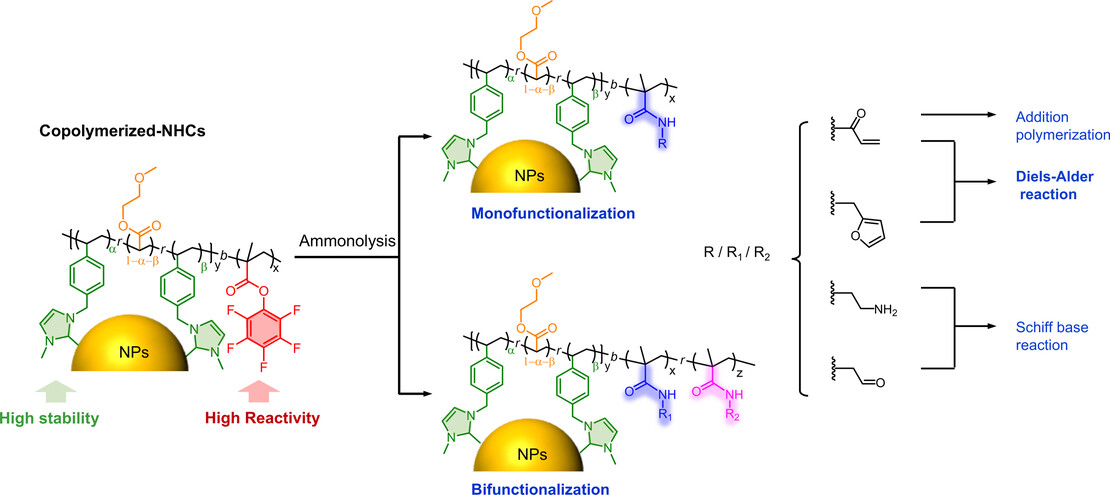
This work presents a method for effective surface functionalization of nanoparticles (NPs) utilizing block copolymers containing nitrogen heterocyclic carbenes blocks and poly(reactive ester) block. This approach enhances NPs′ reactivity and stability, and is applicable to metal, metal oxide, and even rare-earth-doped upconversion NPs, thereby paving new pathways for the design and creation of nanoparticle-based functional materials.
Photodynamic Therapy
Next-Generation Photosensitizers: Cyanine-Carborane Salts for Superior Photodynamic Therapy of Metastatic Cancer
- First Published: 22 January 2025

We report a multifaceted assessment of novel cyanine-carborane salts as potent photosensitizers for photodynamic therapy (PDT). These compounds exhibit efficient tumor targeting through uptake by organic anion-transporting polypeptides (OATP). Upon near-infrared (NIR) light irradiation, cyanine-carborane salts generate reactive oxygen species (ROS), triggering apoptosis and significantly suppressing tumor cell proliferation and migration. In vivo studies demonstrate anti-tumor activity with minimal systemic toxicity, highlighting their potential as next-generation PDT therapeutics.
Photochemistry
Light-Driven Stepwise Reduction of Aliphatic Carboxylic Esters to Aldehydes and Alcohols
- First Published: 21 January 2025

The method described here unlocks the puzzle of the photochemical reduction of aliphatic carboxylic esters by sequential SET/HAT processes under the synergistic action of a phenolate-type photocatalyst and a thiol catalyst. The stepwise reduction of esters to aldehydes and alcohols under mild conditions provides a practical method for fundamental functional group transformation.
Prodrugs
Activatable Photosensitizer Prodrug for Self-Amplified Immune Therapy Via Pyroptosis
- First Published: 17 January 2025
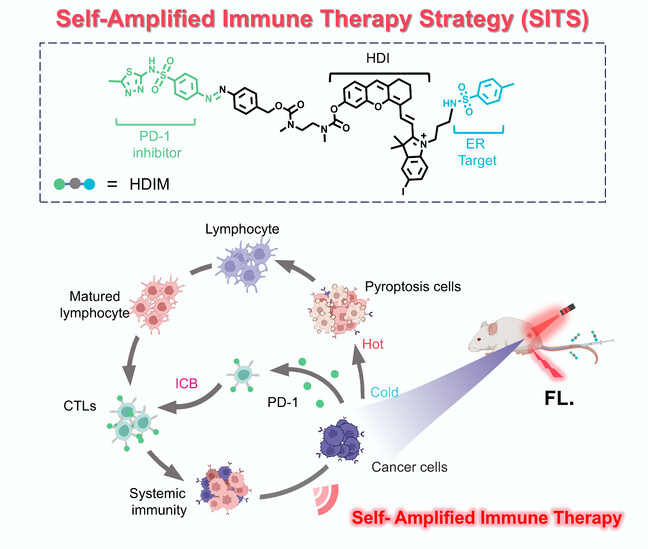
The work proposes a self-amplified immune therapy strategy (SITS) for tumors and reports the first activatable photosensitizer immune-prodrug HDIM based on pyroptosis. Unlike existing combination therapies, HDIM demonstrates a significantly enhanced synergistic and cascading anti-tumor effect. Using HDIM, systemic immune activity is successfully remodeled to prevent tumor infiltration and metastasis.
Gold Nanoclusters
A Stable Open-Shelled Au26 Nanocluster with Remarkable Performance in Selective Oxidation of Benzyl Alcohol
- First Published: 24 January 2025

A stable open-shelled Au26 nanocluster with 15 valence electrons has been synthesized, and the presence of an unpaired electron is confirmed by magnetic measurements. This cluster shows high stability and excellent catalytic performance in selective oxidation of benzyl alcohol, achieving a record high TON of 100670 among atomically precise gold nanoclusters.
Synthetic Methods
Catalytic Asymmetric 1,4-Hydrocarbonation of 1,3-Enynes via Photoredox/Cobalt/Chromium Triple Catalysis
- First Published: 10 January 2025

A synergistic photoredox/cobalt/chromium triple catalysis system have been established, for selective 1,4-hydrocarbonation of readily available 1,3-enyne precursors, providing a modular synthetic platform for various trisubstituted axially chiral allenes bearing an extra central chirality. Furthermore, preliminary mechanistic studies are also conducted.
Nitridophosphates
Adamantane-Type Nitridophosphate Phosphors AExLi10−2xP4N10 : Eu2+ via Medium-Pressure Ion-Exchange Reactions
- First Published: 19 November 2024
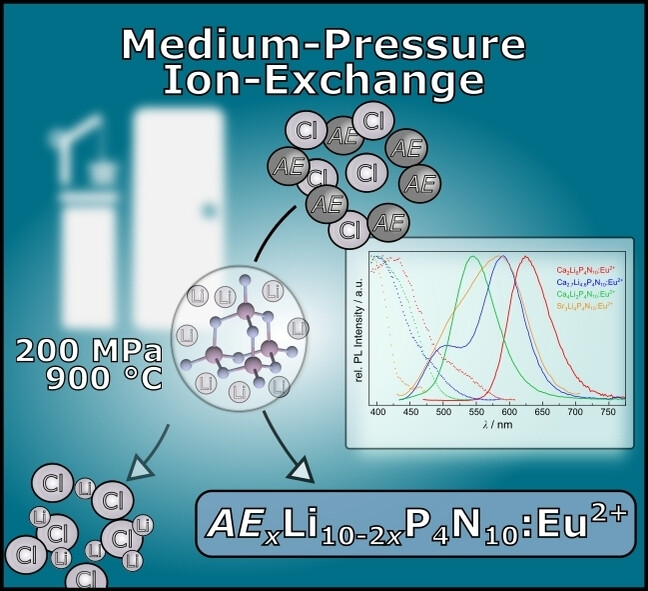
A facile method for the synthesis of nitridophosphate-based phosphors using hot isostatic pressing is presented. Ion exchange reactions starting from the Li-ion conductor Li10P4N10 enables the preparation of single crystals and bulk samples of compounds with the general formula AExLi10−2xP4N10. Upon doping with Eu2+, these compounds exhibit remarkable luminescent properties across the green to red spectral range.
Peptide Self-Assembly | Very Important Paper
The Intrinsic Fluorescence of Peptide Self-Assemblies Across pH Levels
- First Published: 13 December 2024
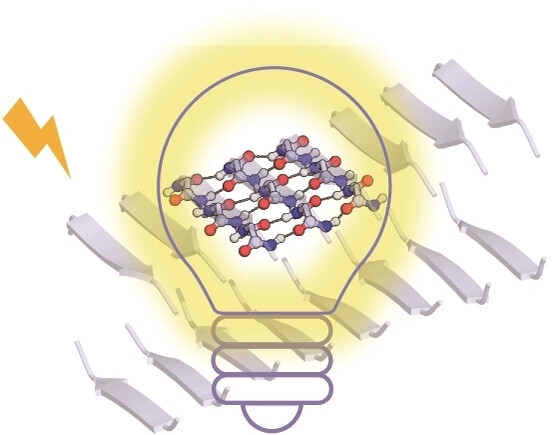
This investigation deciphers the pivotal role of main-chain hydrogen bonding in peptide self-assembly as the primary source of intrinsic fluorescence. It demonstrates how pH-induced morphological diversity in peptides maintains fixed fluorescence peaks through the integrity of these bonding networks, while fluorescence intensity is modulated by structural variations. The study preliminarily unveils the fluorescence properties and regulatory mechanisms of self-assembled peptides.
Porphyrinoids
Coordinative Self-assembly of π-Electron Magnetic Porphyrins
- First Published: 06 December 2024
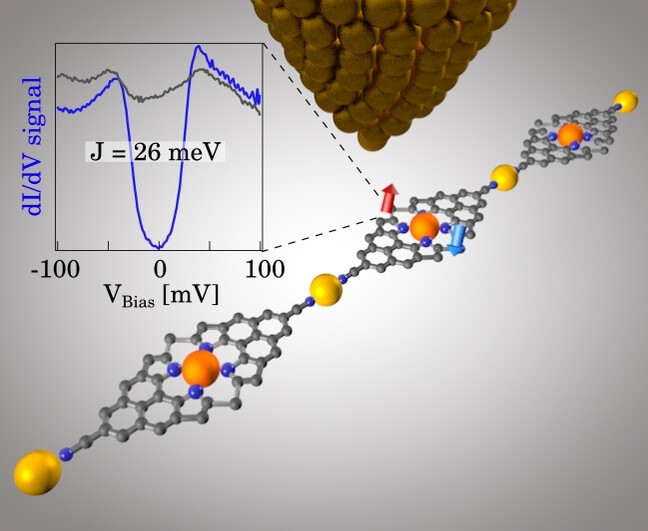
Gold-coordinated polymers of π-extended porphyrins were fabricated by on-surface synthesis and coordination chemistry methods. Each porphyrinoid monomer features antiferromagnetic coupling and no interaction between nearest neighbors within the polymer backbone, behaving as a single magnetic entity.
Supramolecular Chemistry
Dendritic Molecular Baskets for Selective Binding of Toxic Methotrexate
- First Published: 11 November 2024
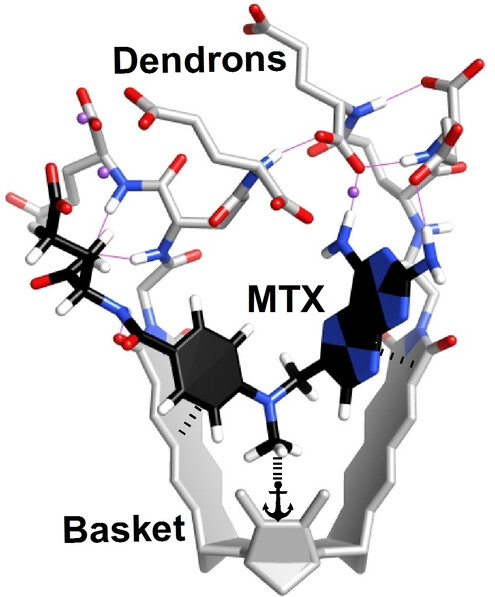
Dendritic molecular baskets are biocompatible cavitands capable of including toxic methotrexate (MTX) in their aromatic cavity. The binding is chemoselective with the complex forming in competitive cell media. With the unique mode of recognition and modular structure, dendritic baskets are leading candidates for developing effective antidotes against MTX poisoning.
Solar Cells
Deciphering the Impact of Aromatic Linkers in Self-Assembled Monolayers on the Performance of Monolithic Perovskite/Si Tandem Photovoltaic
- First Published: 11 December 2024
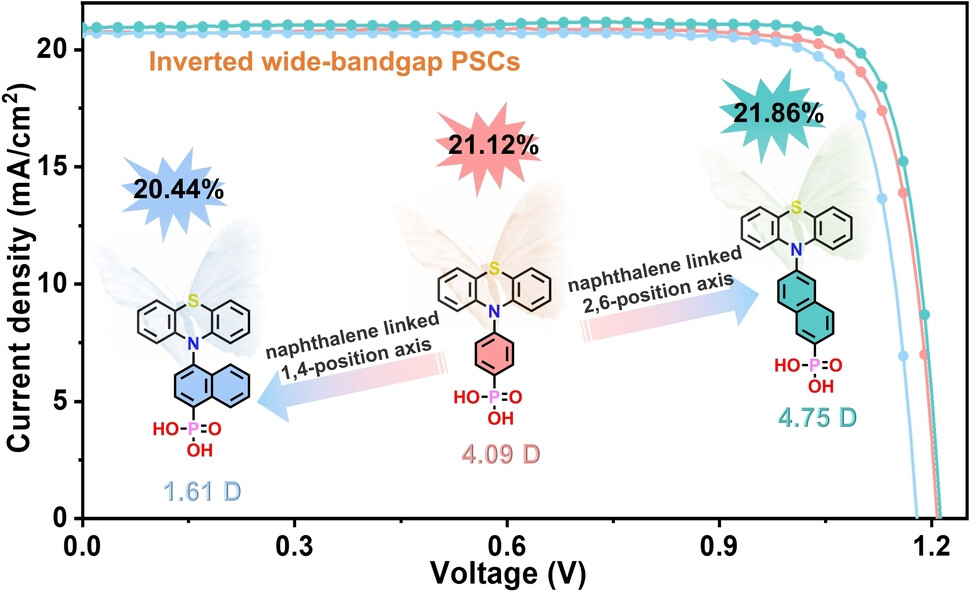
PTZ-SAMs with various aromatic linkers and linking orientations were designed and synthesized as the hole-selective layer (HSL) in inverted wide-band gap perovskite solar cells (PSCs). β-NapPAPT could form dense and highly ordered HSLs, enhancing interfacial interactions and favoring optimal energy level alignment with the perovskite films.
Photocatalysis | Hot Paper
Buffered Hydroxyl Radical for Photocatalytic Non-Oxidative Methane Coupling
- First Published: 12 January 2025
Oxygen Evolution | Very Important Paper
Ru0.1Mn0.9Ox Electrocatalyst for Durable Oxygen Evolution in Acid Seawater
- First Published: 24 November 2024
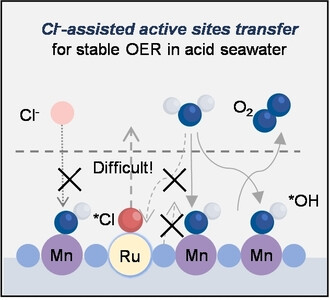
We report a Cl−-assisted active site transfer strategy on Ru0.1Mn0.9Ox, achieving high OER selectivity and long-term stability in acidic seawater. Typically, *Cl occupies the Ru site, shifting the OER center to CER-insensitive Mn, preventing metal site dissolution. Additionally, the active Mn sites create an environment that favors OER over CER, offering a selective and durable solution for acidic seawater electrolysis.
Water Harvesting
Low Evaporation Enthalpy Ionic Covalent Organic Frameworks for Efficient Atmospheric Water Harvesting at Low Humidity
- First Published: 16 December 2024
CO2 Hydrogenation | Hot Paper
Low-temperature CO2 Hydrogenation to Olefins on Anorthic NaCoFe Alloy Carbides
- First Published: 19 November 2024
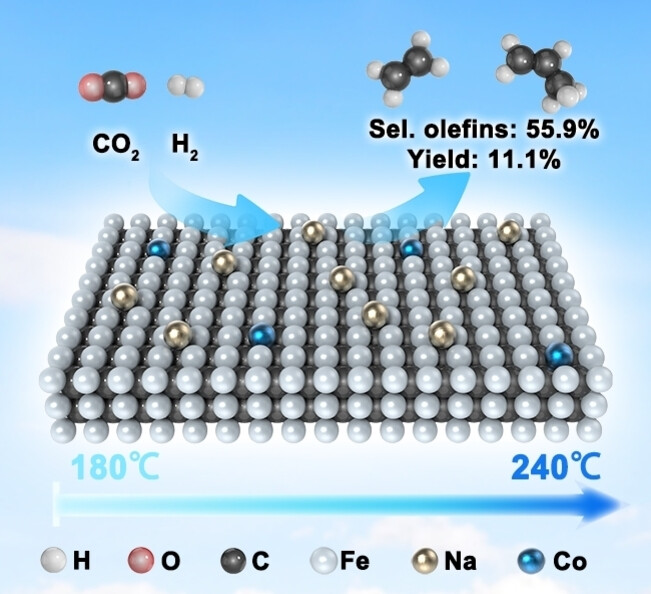
A highly active (FexCoy)5C2 structure is developed through the synergistic effect of electronic (sodium) and structural (cobalt) promoters. This strategy facilitates the hydrogenation of carbon dioxide into olefins at a low temperature of 240 °C, achieving the highest STY of olefins at low temperatures, even better than a significant proportion under high-temperature operating conditions. Additionally, it retains the capability to synthesize olefins at 180 °C.
Photosensitizers
Electron Transfer Mediator Modulates Type II Porphyrin-Based Metal–Organic Framework Photosensitizers for Type I Photodynamic Therapy
- First Published: 19 November 2024

An effective and universal electron transfer-based strategy is introduced to modulate the reactive oxygen species (ROS) generation in porphyrin-based metal–organic frameworks (MOFs). This approach enables the conversion of existing Type II MOFs into Type I MOFs with hypoxic tolerance to function effectively under low-oxygen conditions, providing new insight into the development of Type I MOFs.
Recyclable Thermosets | Very Important Paper
Tailoring the Reprocessability of Thiol-Ene Networks through Ring Size Effects
- First Published: 26 December 2024
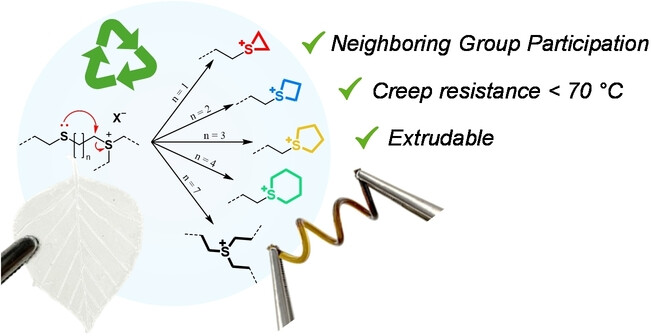
Reprocessing of thiol-ene networks was accomplished by carefully tuning the relative distance between two thioether functionalities and elevating the neighboring group participation concept. As a result we achieved a fast bond exchange at high temperatures. This allowed extrusion processing of cross-linked materials, while maintaining structural integrity below 70 °C.
Energy Transfer
Efficient Energy Transfer from Quantum Dots to Closely-Bound Dye Molecules without Spectral Overlap
- First Published: 29 October 2024
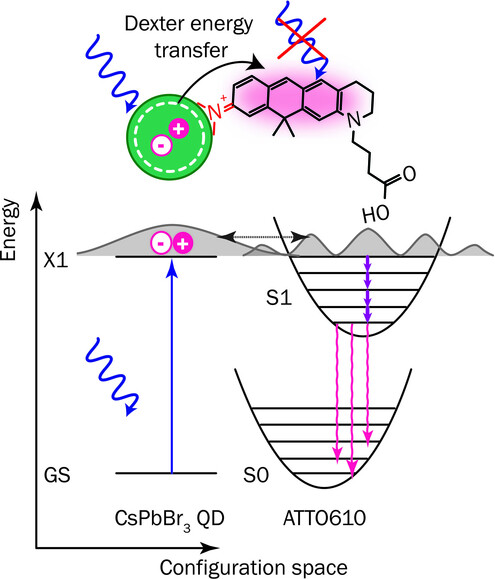
This work designs a perovskite quantum dot (QD)-dye system for efficient energy transfer (ET) from QDs to dyes occurring via the Dexter exchange-type interaction, at minimal donor-acceptor spectral overlap. Dyes containing a dimethyl iminium binding group as part of their conjugated system are chosen for high binding affinity to QD surface, crucial for donor-acceptor spatial wavefunction overlap for efficient ET.
CO2 Reduction
Enhancing CO2 Electroreduction to Multicarbon Products by Modulating the Surface Microenvironment of Electrode with Polyethylene Glycol
- First Published: 08 January 2025
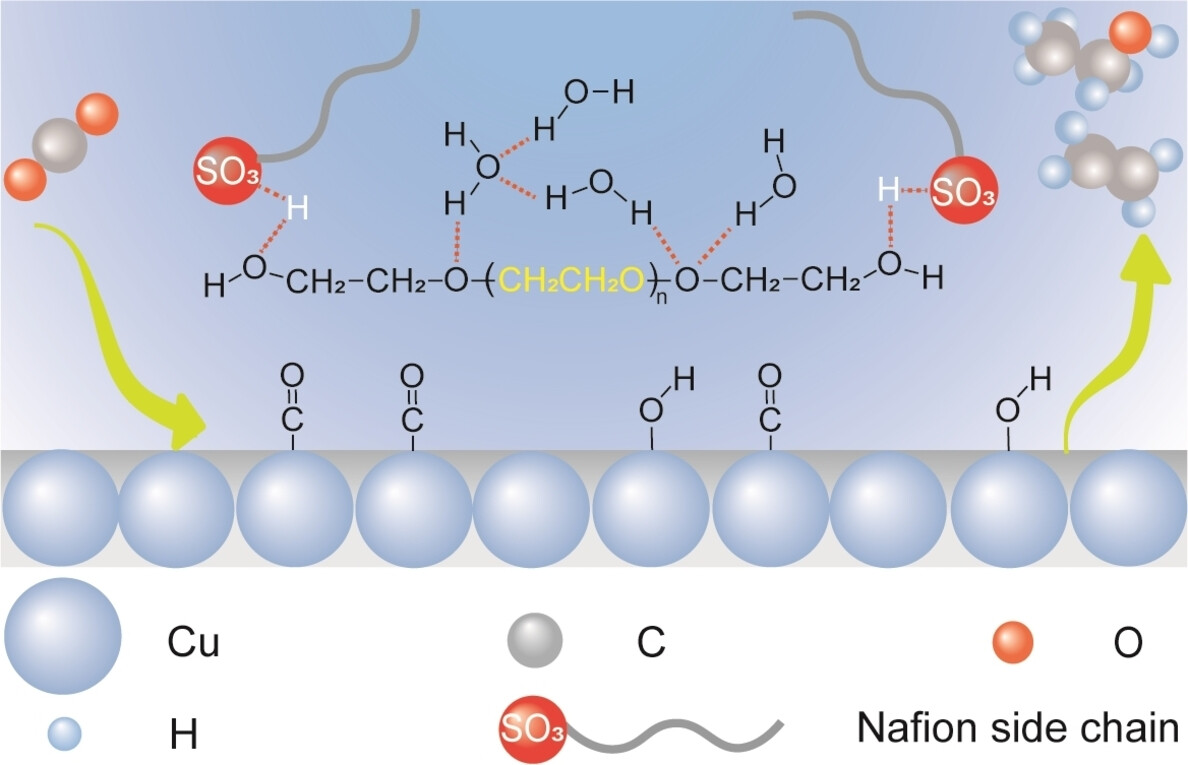
PEG was incorporated into the Cu electrode, achieving an FEC2+ of 90.3 % at 500 mA cm−2. This modification relaxes Nafion, increasing active site availability and enhancing *CO and *OH adsorption, promoting C−C coupling. Simultaneously, the restructured hydrogen bond network reduces active hydrogen species, suppressing the hydrogen evolution reaction.
Asymmetric Catalysis
Strained Dehydro-[2,2]-paracyclophane Enabled Planar Chirality Construction and [2.2]Paracyclophane Functionalization
- First Published: 13 January 2025
![Strained Dehydro-[2,2]-paracyclophane Enabled Planar Chirality Construction and [2.2]Paracyclophane Functionalization](/cms/asset/1573569d-8e54-4c06-b354-37ffc695782f/ange202420667-toc-0001-m.jpg)
A practical synthesis of strained dehydro-[2,2]-paracyclophane, a benzyne analogue of [2.2]paracyclophane was realized and it could be utilized in various strain-release nucleophilic or cycloaddition reactions to synthesize diverse functionalized [2.2]paracyclophanes. A copper-catalyzed enantioconvergent alkynylation of this intermediate generated valuable planar chiral PCP building blocks and heterocycles in good yields with excellent enantioselectivity. This method provides a new general platform for challenging planar chirality construction.
Photocatalysis
Visible-Light Photocatalyzed Skeletal Rearrangement Enables the Synthesis of Highly Functionalized Xanthenes with Antitumor Activity
- First Published: 23 December 2024
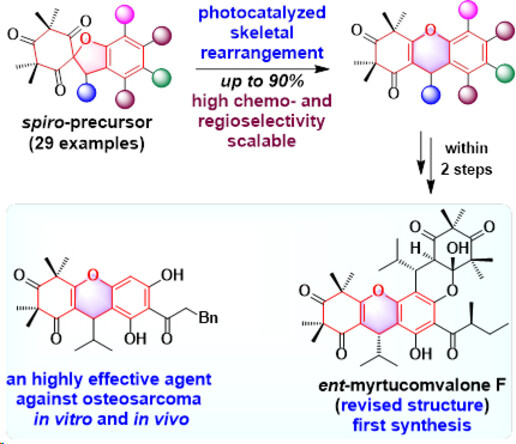
This study presents the first example of a photocatalyzed intramolecular skeletal rearrangement strategy for constructing the xanthene scaffold. This approach has been successfully applied to synthesize highly functionalized xanthenes and to revise the structures of myrtucomvalones E and F. Furthermore, biological studies reveal that a xanthene demonstrates significant antiosteosarcoma activity both in vitro and in vivo.
Trifluoromethylation
The Role of Electron Transfer in Copper-Mediated C(sp2)−H Trifluoromethylation
- First Published: 03 December 2024
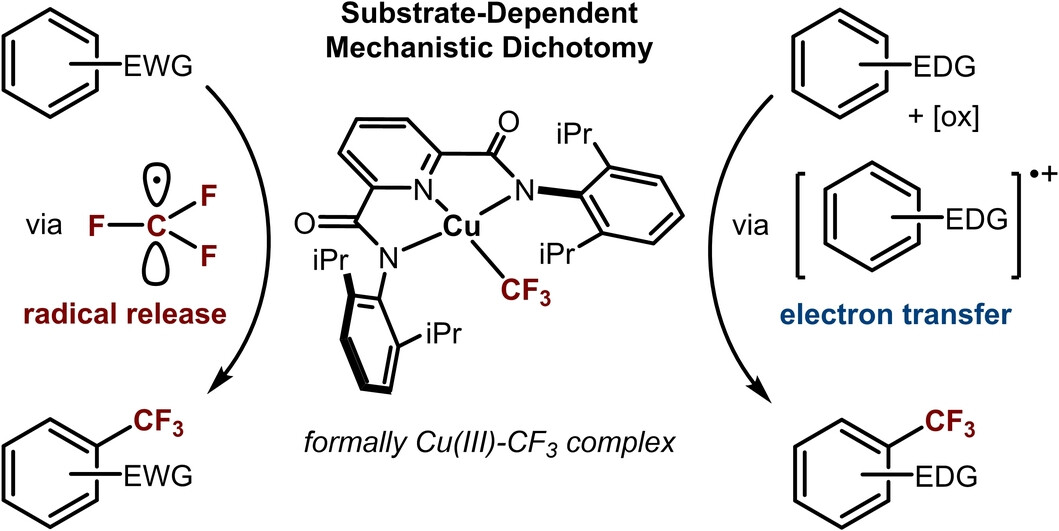
Copper(II) and copper(III) trifluoromethyl complexes were used to elucidate the mechanism of Cu-mediated C(sp2)−H trifluoromethylation. For electron-rich substrates, a previously unidentified single electron transfer (SET) mechanism is followed, whereas electron-poor substrates follow CF3 radical release/electrophilic aromatic substitution (SEAr).
Carbon Electrodes
Unlocking Mesoscopic Disorder in Graphitic Carbon with Spectroelectrochemistry
- First Published: 30 December 2024
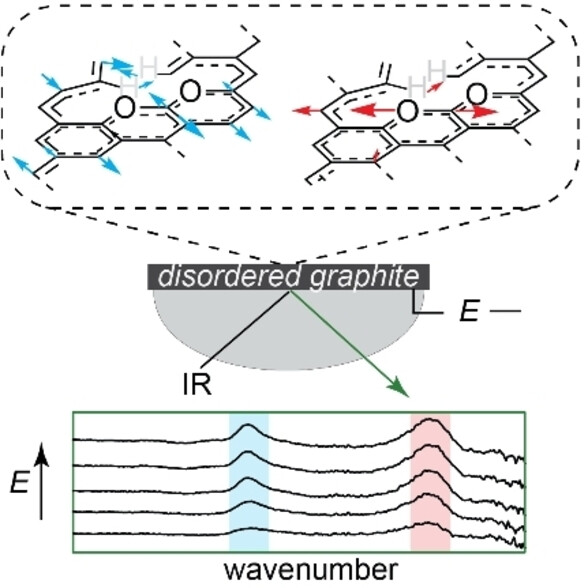
We show that graphitic carbon electrodes exhibit electric-field dependent infrared activity that is sensitive to the bulk mesoscopic intrinsic disorder. Our combined experimental and theoretical work provides a roadmap for elucidating mesoscopic disorder in graphitic carbon electrode materials under potential bias.
Perovskite Solar Cells
Achieving over 20 % Efficiency in Laminated HTM-Free Carbon Electrode Perovskite Solar Cells through In Situ Interface Reconstruction
- First Published: 26 December 2024
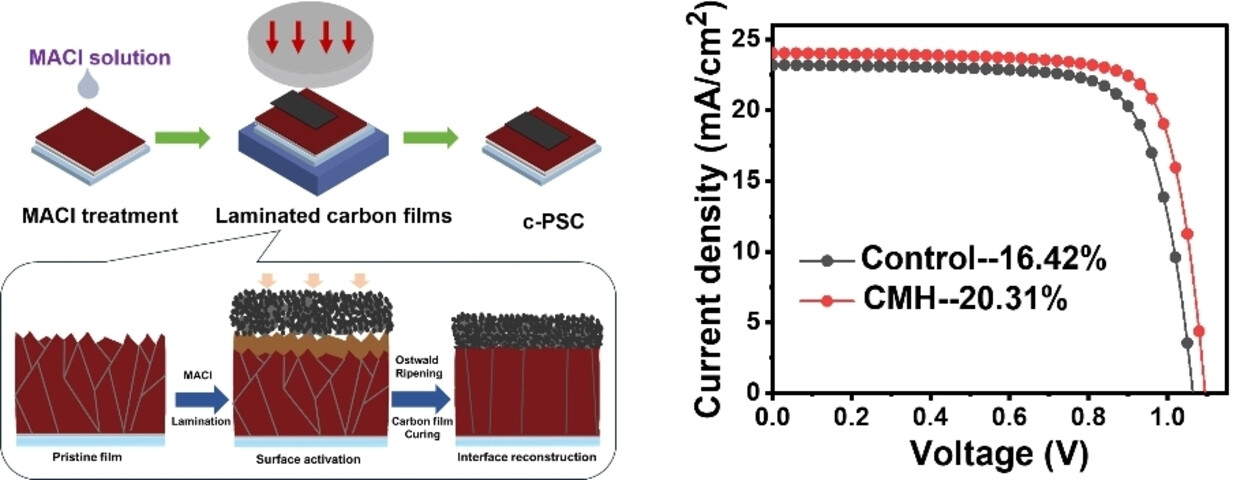
We reported a chemical-mechanical in situ interface reconstruction strategy for the fabrication of HTM-free carbon electrode perovskite solar cells (c-PSCs) by laminating a free-standing carbon electrode onto perovskite film. Our new strategy overcomes the contact issues within the perovskite/carbon electrode interface and boosts the efficiency to 20.31 % with enhanced stability.
Sustainable Chemistry | Hot Paper
Solvent-Free Chemical Recycling of Polyesters and Polycarbonates by Magnesium-Based Lewis Acid Catalyst
- First Published: 24 December 2024

A MgCl2 catalyst system exhibits high selectivity and compatibility towards the depolymerization of the aliphatic (co)polyesters and polycarbonates under mild, solvent-free conditions (up to 98 % monomer yields). This approach provides a promising solution to the circular utilization of plastic materials.
Polymer Electrolytes
Regulating Crystalline Phase/Plane of Polymer Electrolyte for Rapid Lithium Ion Transfer
- First Published: 16 December 2024

A new insight into the mechanism of crystal phase and plane exerts on the transfer of lithium ion in poly(vinylidene fluoride)-hexafluoropropylene (PVDF-HFP) based polymer electrolytes is investigated in depth. β-phase-dominant segments are obtained by regulating dissolving process and the newly exposed (111/201)β crystal planes are conducive to provide more ion transport channels, which is beneficial to the rapid and smooth transfer of lithium ion.
Information Encryption | Very Important Paper
Evolution of Supramolecular Coordination Assemblies Visually Monitored by Time-Dependent Multicolor Fluorescence
- First Published: 01 December 2024
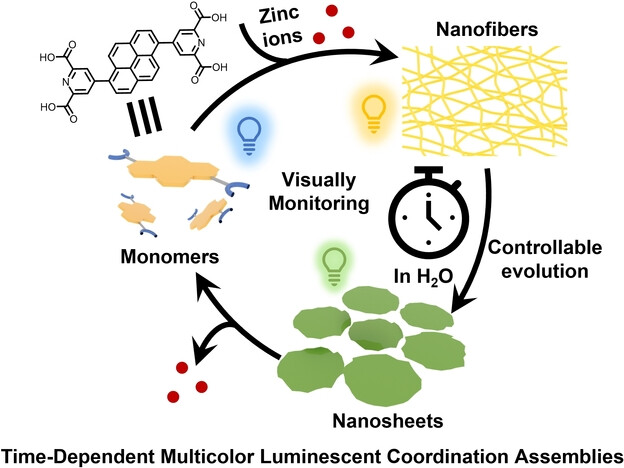
The metastable nanofiber structures triggered by the synergistic effect of π–π stacking and coordination between zinc ions and the organic ligands evolved into nanosheet assemblies over time in water, accompanied by fluorescence changes that enabled visual monitoring. This strategy could be extended to multiple ions and offers applications in temporal dynamic fluorescence encryption.
Polymerization
Acid-Enhanced Photoiniferter Polymerization under Visible Light
- First Published: 25 December 2024
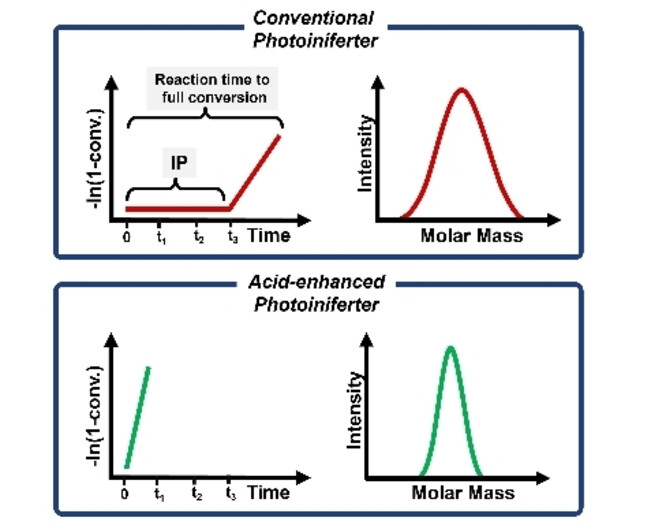
An acid-enhanced photoiniferter polymerization operating efficiently under visible light is reported. Addition of biocompatible citric acid, accelerates photolysis, eliminating induction periods by enhancing chain transfer agent consumption and reaction rates. This method yields well-defined polymers with near-quantitative conversions in just two hours and demonstrates versatility across various monomers, including the synthesis of high molecular weight polymers.
Porous Organic Frameworks | Very Important Paper
Targeted Synthesis of Interpenetration-Free Mesoporous Aromatic Frameworks by Manipulating Catalysts as Templates
- First Published: 27 November 2024

By tuning the size of the catalyst ligand, a mesoporous aromatic framework, PAF-333, was obtained. It was found that the steric hindrance of larger-sized ligands avoided the framework interpenetration. Thanks to its large pore volume (3.4 cm3 g−1), it could adsorb 13.4 wt % of hydrogen at 77 K, 100 bar and 0.537 g g−1 of methane at 298 K, 98 bar, making it an ideal candidate for large-scale on-board methane storage.
Clusters for Heterogeneous Catalysis
A Hollowed-Out Heterometallic Cluster for Catalytic Knoevenagel Condensation
- First Published: 12 November 2024
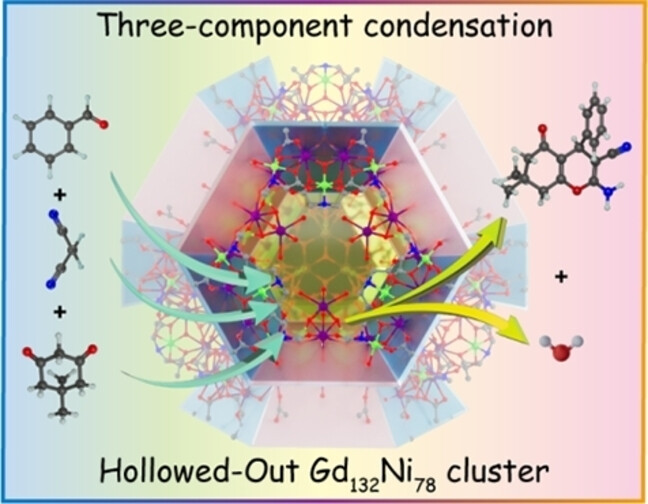
Two isostructural lanthanide-nickel clusters Ln132Ni78 (Ln=Gd, Eu) were synthesized by the co-hydrolysis of Ln3+ and Ni2+ in the presence of iminodiacetate. Both clusters feature a hollow truncated tetrahedral structure with trumpet-shaped passageways that connect the exterior and the interior of the cluster cage. The solution-stable cluster has been shown to catalyze size-selective Knoevenagel condensation and one-pot three-component synthesis of 4H-pyran derivatives.
Aqueous Zinc Batteries | Hot Paper
Manipulating Interphase Chemistry for Aqueous Zn Stabilization: The Role of Supersaturation
- First Published: 27 December 2024
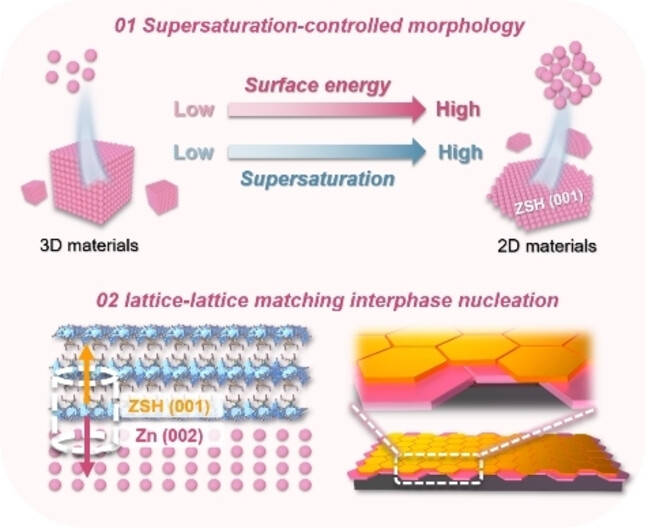
We highlight the role of local supersaturation in governing the fundamental crystallization chemistry of Zn4SO4(OH)6⋅xH2O (ZSH) and propose a subtle supersaturation-controlled morphology strategy to tailor the interphase chemistry of Zn anode. Attributed to the supersaturated environment created by caprolactam, ZSH selectively exposes high-energy (001) plane and initiates a pseudo-coincidence interface that significantly boosts the Zn lifespan.
Polyoxometalates
Host-Guest Assemblies of Polyoxovanadate Clusters as Supramolecular Catalysts
- First Published: 13 November 2024
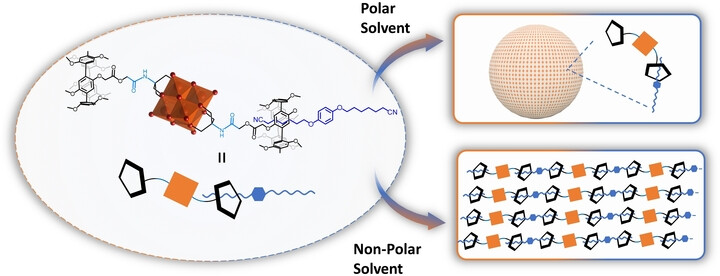
An efficient strategy for embedding catalytically active polyoxovanadate (POV) into supramolecular assemblies was developed by utilizing host-guest interactions between pillararenes grafted on the cluster and ditopic linkers. The amphiphilic nature of the POV in the host-guest complex promoted responsive behavior of the assembly toward the solvent polarity. Lastly, the assembly showed enhanced catalytic properties compared to the parent POV.
DNA Nanotechnology
Photomodulated Transient Catalytic Constitutional Dynamic Networks and Reaction Circuits
- First Published: 05 January 2025
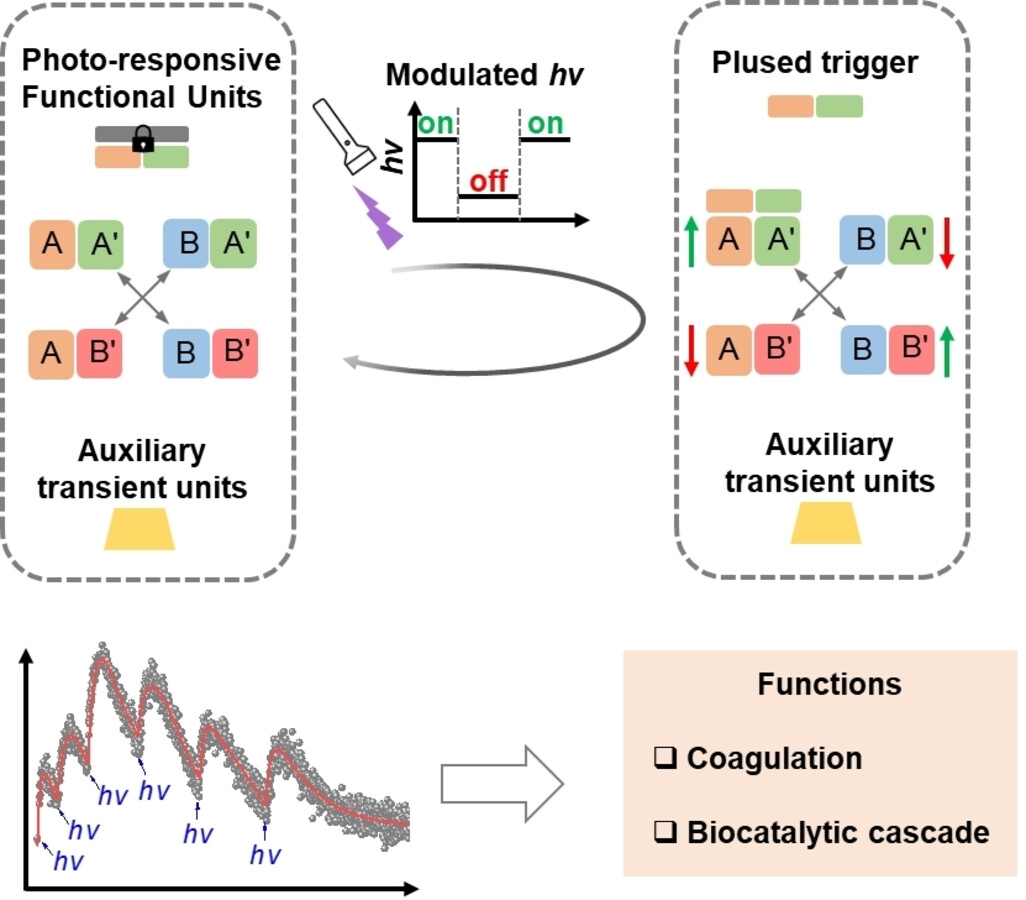
Photomodulation of dynamic DNA circuits/networks is demonstrated by photoprotection of an auxiliary caged unit yielding an oligonucleotide intervening with the temporally operating circuits. This is exemplified with photomodulation of DNAzyme or of dynamically operating DNA networks. The concept is applied to photomodulated network-guided inhibition of fibrinogenesis and controlling biocatalytic cascades.
Radicals
Isolated Neutral Organic Radical Unveiled Solvent-Radical Interaction in Highly Reducing Photocatalysis
- First Published: 03 January 2025
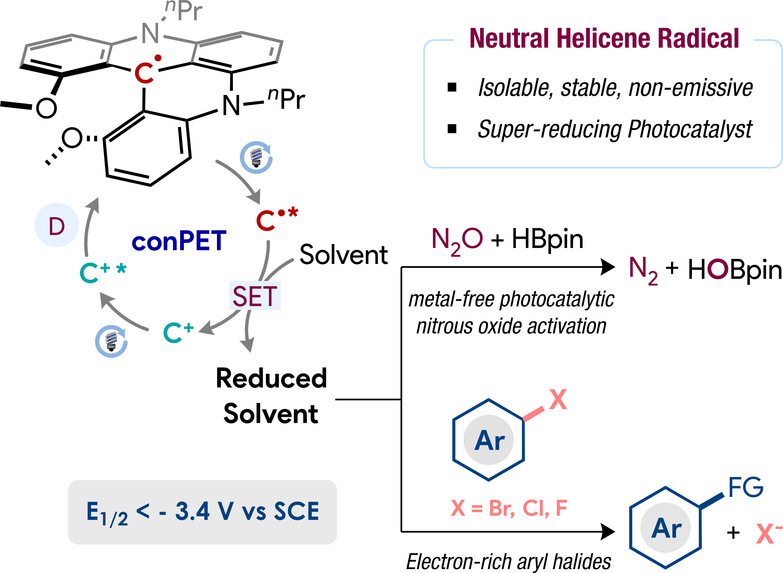
Isolated neutral helicene radical revealed the missing link in highly photoreducing consecutive photoelectron transfer (conPET) mechanism. Extensive mechanistic studies implied interaction of short-lived, non-emissive photoexcited radical and acetonitrile that generates reduced solvent. To that end, numerous extreme photoreduction have been showcased through useful functionalization of aryl halides using reduced solvent mediated conPET method.
Autophagy Imaging | Hot Paper
Vanadium Flow Batteries | Very Important Paper
In-Situ Constructed Core-Shell Catalyst Enabling Subzero Capacity Unlocking of Cost-Effective and Long-Life Vanadium Flow Batteries
- First Published: 17 December 2024
NLO Materials | Hot Paper
Unconventional Heterobidentate Coordination of 4-Hydroxypyridine Leading to Remarkably Strong Second-Harmonic Generation in Zn(C5H4NO)2
- First Published: 26 November 2024
Methanol Oxidation Reaction | Hot Paper
Adjacent-Ligand Tuning of Atomically Precise Cu−Pd Sites Enables Efficient Methanol Electrooxidation with a CO-Free Pathway
- First Published: 23 December 2024
Homogeneous Catalysis | Hot Paper
Diverse Synthesis of Arene-Fused [n.1.1]-Bridged Molecules via Catalytic Cycloaddition and Rearrangement Reactions
- First Published: 23 December 2024
Oxygen Evolution
Chloride Residues in RuO2 Catalysts Enhance Its Stability and Efficiency for Acidic Oxygen Evolution Reaction
- First Published: 10 January 2025

Chlorine-containing RuO2 catalysts and pure RuO2 catalysts with comparable morphology and crystallinity were synthesized to clarify the effects of chlorine residues on the performance of RuO2. Notably, the RuO2-Cl catalyst exhibited superior activity and stability in acidic OER by lowering the limiting potential and suppressing the LOM pathway, maintaining high performance for over 1200 hours at high current densities.
Li−S Batteries
Alloying Strategy Regulating Size and Electronic Structure of Mo0.25Nb0.75Se2 to Achieve High-Performance Lithium−Sulfur Batteries
- First Published: 02 December 2024
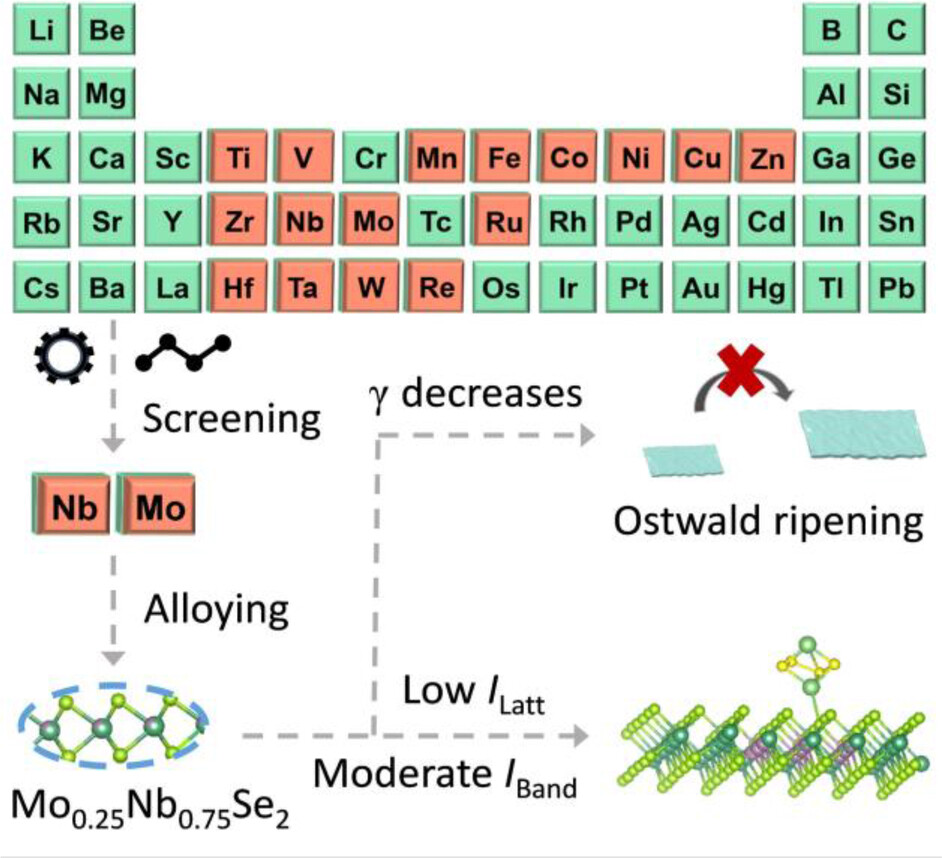
Guided by binary descriptors, 16 transition metal selenides are screened, and an alloying strategy is subsequently employed to controllably synthesize Mo0.25Nb0.75Se2/NG. This approach significantly reduces the surface energy while precisely tuning the band alignment and lattice matching between polysulfides and Mo0.25Nb0.75Se2/NG, thereby enhancing interfacial reaction kinetics and enabling the successful construction of high-performance lithium−-sulfur batteries.
Photocatalytic H2O2 Synthesis
Non-Radical Mediated Photocatalytic H2O2 Synthesis in Conjugate-Enhanced Phenolic Resins with Ultrafast Charge Separation
- First Published: 11 December 2024
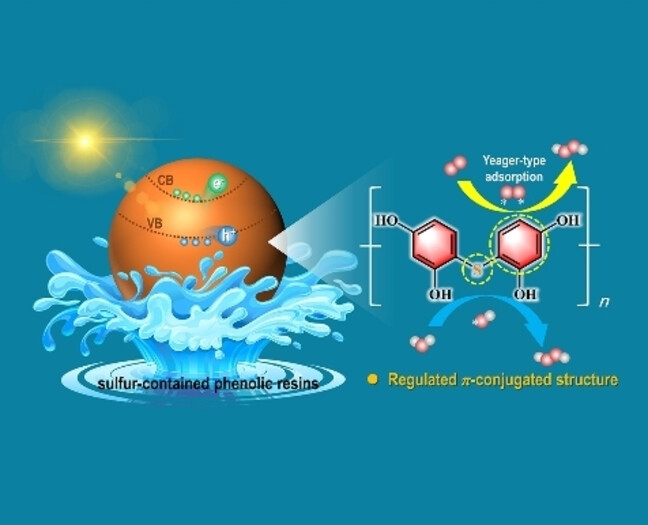
A sulfur-infused phenolic (RS) resin photocatalyst was meticulously designed at the molecular level to fine-tune its conjugation degree, thereby enhancing both its charge separation capability and hydrophilicity. This structural optimization enables the RS resin to achieve overall photocatalytic H2O2 synthesis via non-radical pathways, resulting in an outstanding solar-to-chemical conversion efficiency of 1.4 %.
Electrocatalytic Nitrate Reduction | Hot Paper
Selenium-Deficient FeSe2/Fe3O4 Electrocatalyst for Nitrate Reduction to Ammonia
- First Published: 24 December 2024
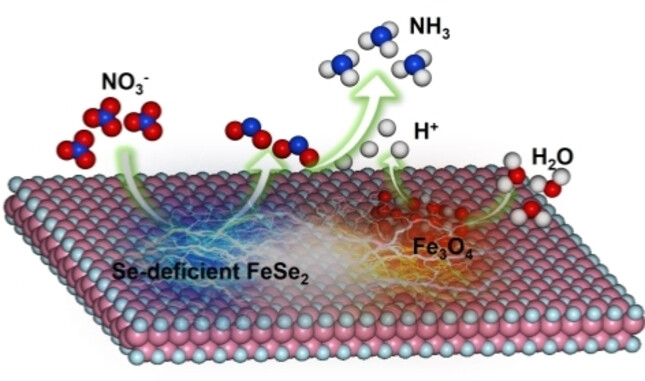
The slow kinetics of the proton-coupled electron transfer process results in the low conversion efficiency of NO3RR. Selenium-deficient FeSe2/Fe3O4 heterojunction is synthesized. The Se-deficient FeSe2 contributes to nitrate-deoxidation and hydrogenation, and Fe3O4 promotes water decomposition to provide H protons, which jointly promotes NO3RR.
Photocatalytic H2O Splitting | Hot Paper
Decoupling H2 and O2 Release in Particulate Photocatalytic Overall Water Splitting Using a Reversible O2 Binder
- First Published: 15 December 2024
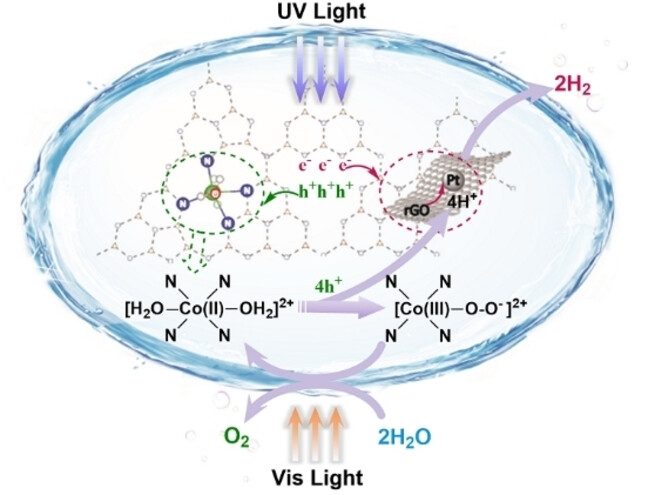
Co(5 %)-HPCN/(rGO/Pt) consisting of photoresponsive chip (HPCN), H2 evolution cocatalyst (rGO/Pt), and cobalt complex capable of reversibly binding O2 ([Co(II)N4(H2O)2]2+) is constructed to achieve the decoupling of particulate photocatalytic overall water splitting under alternating UV and visible light irradiations. Under UV irradiation, the photogenerated holes oxidize [Co(II)N4(H2O)2]2+ into [Co(III)N4(O2−)]2+ and H+, while the photogenerated electrons transfer to Pt through rGO for reduction of H+ to H2. Under visible irradiation, [Co(III)N4(O2−)]2+ is photolyzed back to [Co(II)N4(H2O)2]2+ along with O2 evolution.
Homogeneous Catalysis
Copper-Catalyzed Regioselective and Enantioselective Hydropyridylation of Dienes for the Synthesis of Chiral Diaryl Compounds via Concerted Nucleophilic Aromatic Substitution
- First Published: 26 November 2024
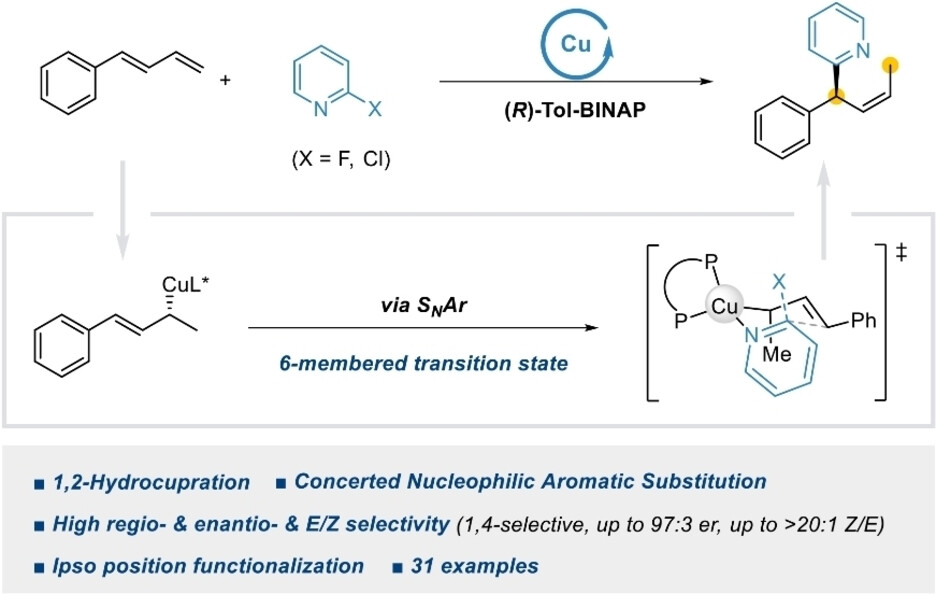
A copper-catalyzed enantioselective and 1,4-selective hydropyridylation has been developed. Using 2-fluoropyridine as the electrophile and a copper catalyst in conjunction with (R)-Tol-BINAP, the desired chiral 1,1-diaryl product was synthesized via a concerted nucleophilic aromatic substitution mechanism.
G-quadruplex | Hot Paper
Locking up G-Quadruplexes with Light-Triggered Staples Leads to Increased Topological, Thermodynamic, and Metabolic Stability
- First Published: 25 November 2024

A photochemical method for “stapling” G-quadruplex (G4) and intercalated motif (IM) structures enhances their stability, locks their topology, and increases enzymatic resistance while preserving biological activity. This method, applied to the Thrombin Binding Aptamer (TBA) model and other G4- and IM-prone sequences, shows promise for future therapeutic applications, including more stable aptamers and molecular decoys in biological systems.
Photovoltaic Electrolysis
A 17.73 % Solar-To-Hydrogen Efficiency with Durably Active Catalyst in Stable Photovoltaic-Electrolysis Seawater System
- First Published: 23 December 2024
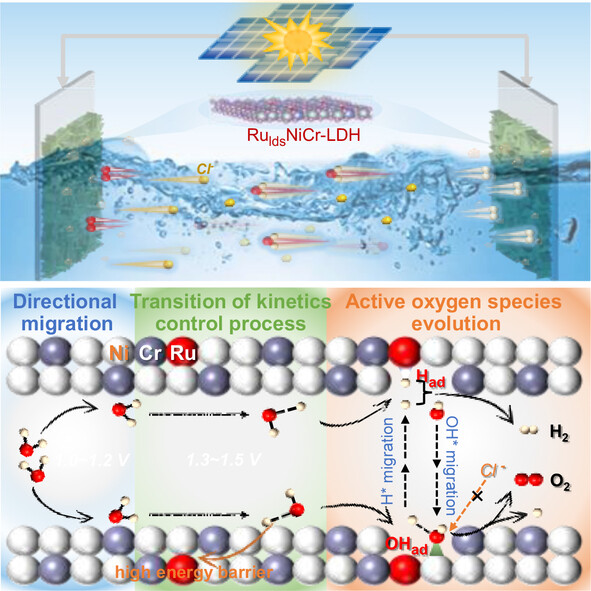
This study provides a forward-looking direction for the economically scalable production of green hydrogen and showcases an innovative insight for the dynamic evolutionary mechanism of interfacial-water dissociation-oxidation. The photovoltaic-electrolysis system efficiently converts renewable energy sources into hydrogen, the integration of durable RuldsNiCr-LDH catalyst promises industrial application viability. And the newly defined PVTH parameter sets a new benchmark for photovoltaic-electrolysis systems.
Fluorescence | Very Important Paper
Glycerol Oxidation | Very Important Paper
Active Hydroxyl-Mediated Preferential Cleavage of Carbon-Carbon Bonds in Electrocatalytic Glycerol Oxidation
- First Published: 07 January 2025
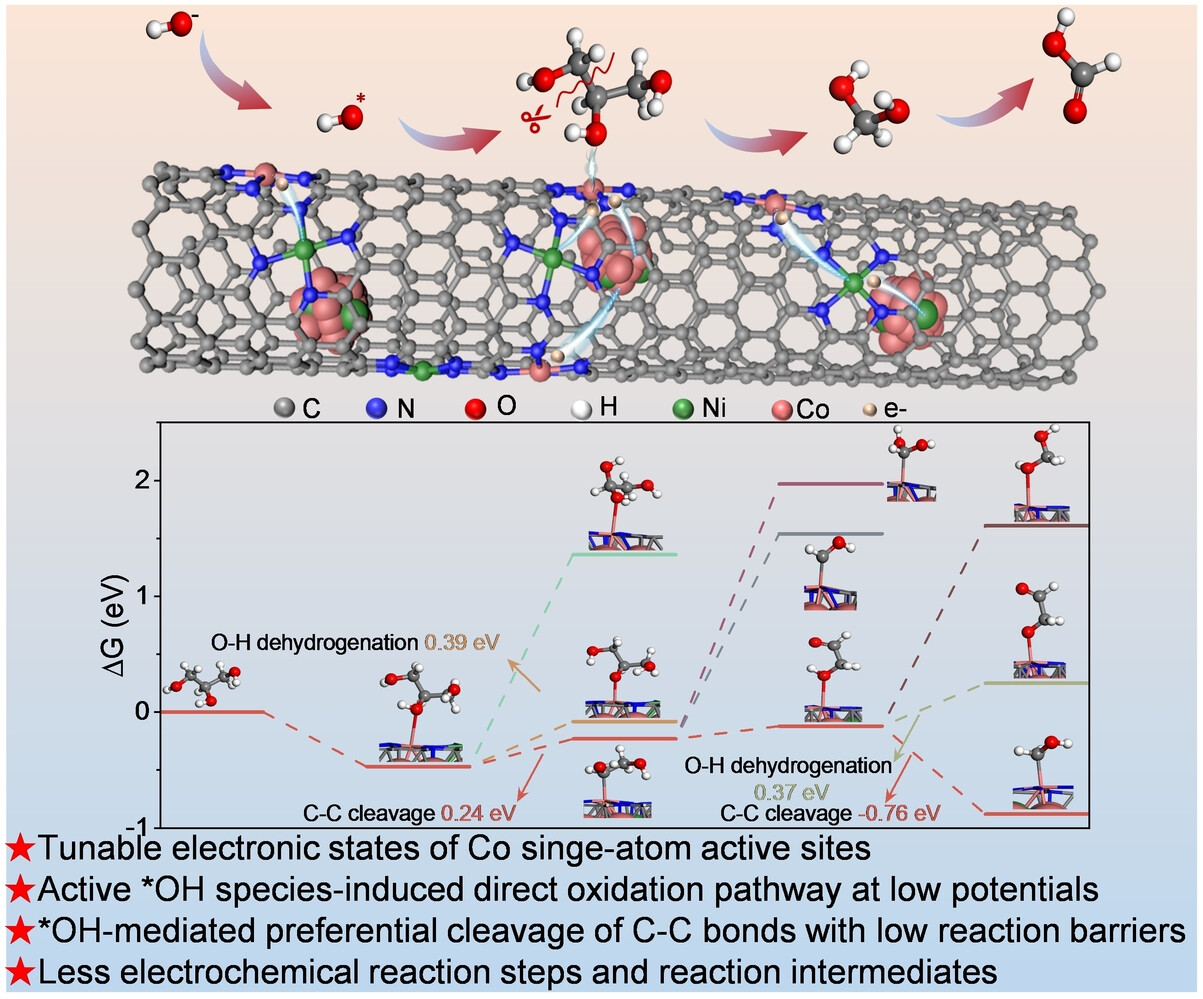
An electrocatalyst of Ni0.1Co0.9 alloy embedded in nitrogen-doped carbon nanotubes decorated with Ni−Co dual-atoms is constructed for glycerol oxidation reaction (GOR). The active *OH makes the GOR follow a direct oxidation pathway occurring at lower potentials. The optimized electronic state of Co single-atom regulated by Ni single-atom and Ni0.1Co0.9 alloy promotes *OH-mediated preferential cleavage of C−C bonds, leading to a high formate yield.
Electrocatalysis
Charge Manipulation of Porous Coordination Cages Tunes the Efficiency and Selectivity in Electrochemical Synthesis
- First Published: 23 December 2024
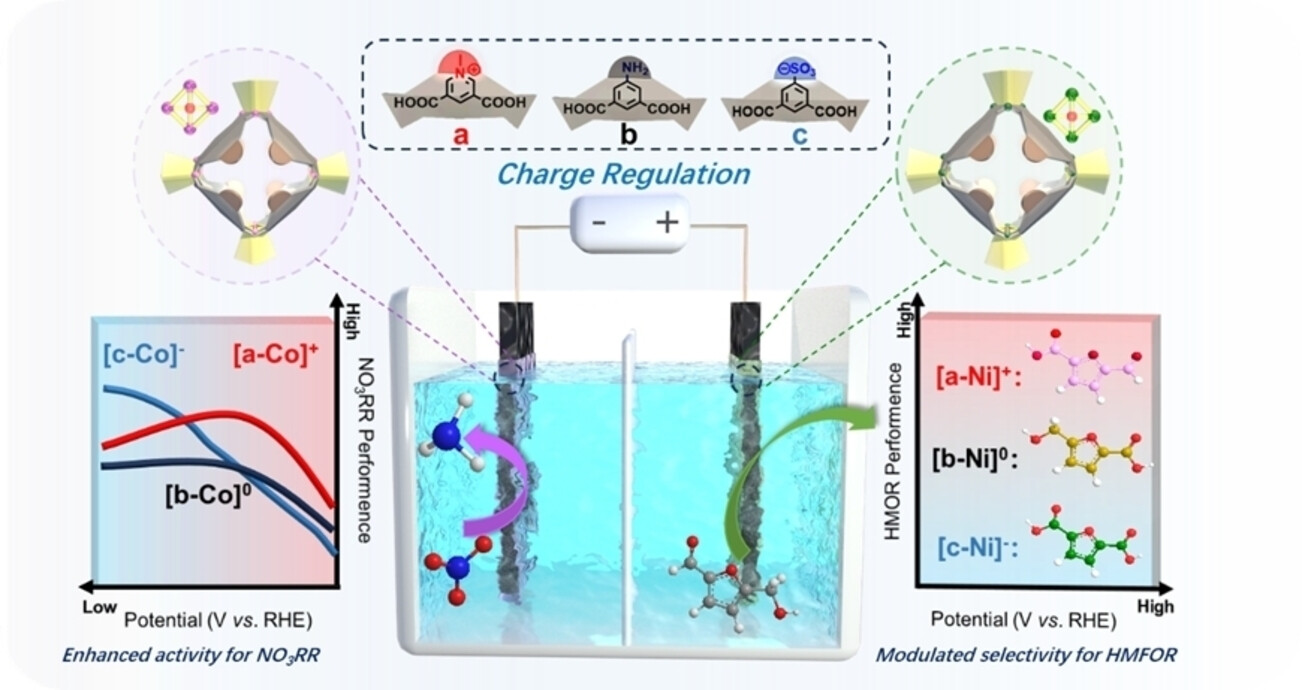
The charge species of the porous coordination cages are regulated by ligand strategy. The charge-tunable porous coordination cages exhibit performance tweaking ability in the electrocatalytic nitrate reduction coupled 5-hydroxymethylfurfural oxidation system, which can not only indirectly adjust the efficiency of nitrate electrosynthesis of ammonia, but also modulate the product selectivity of 5-hydroxymethylfurfural oxidation.
Polymer Chemistry | Very Important Paper
New Thermoplastic Elastomers based on Ethylene-Butadiene-Rubber (EBR) by Switching from Anionic to Coordinative Chain Transfer Polymerization
- First Published: 17 December 2024

Thermoplastic elastomers: Olefin triblock copolymers based on glassy polystyrene, ethylene butadiene rubber and highly crystalline polyethylene segments are prepared using a switch strategy from anionic polymerization to coordinative chain transfer (co)polymerization. They display low-viscosity above the melting point of PE and high elastic performances upon crystallization of PE segments.
Lithium Metal Batteries
A Lithiophilic Donor–Acceptor Polymer Modified Separator for High-Performance Lithium Metal Batteries
- First Published: 23 December 2024
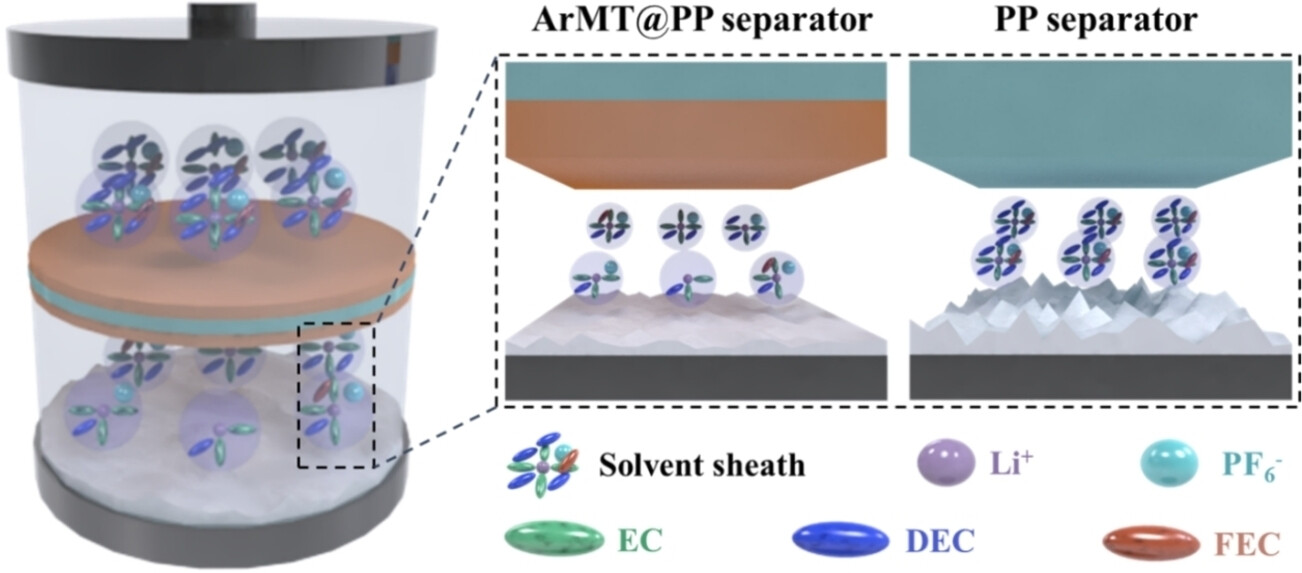
A donor–acceptor polymer (ArMT) consisting of benzene rings and triazine was obtained and modified onto polypropylene (ArMT@PP) as separators for lithium metal batteries (LMBs). Due to the lithiophilic triazine units, this ArMT@PP simplifies the solvation structure of Li+, facilitates the migration of Li+ and forms a stable solid electrolyte interface. The assembled LMBs achieved a capacity retention of 90.58 % after 1200 cycles at 1 C.
Polycyclic Hydrocarbons
Intramolecular Charge Transfer in Antiaromatic Donor/Acceptor-Fused s-Indacenes
- First Published: 05 December 2024
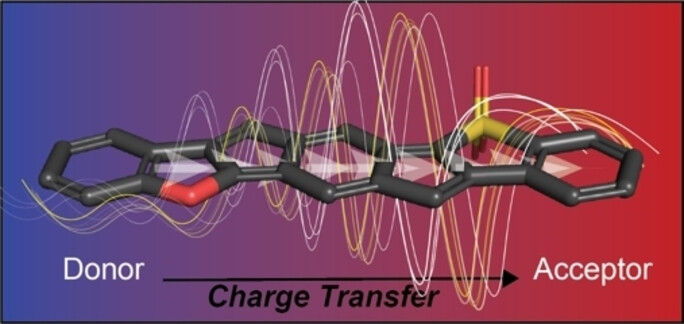
Late-stage oxidation of unsymmetrical benzofuran/benzothiophene-fused s-indacene regioisomers to their corresponding sulfones affords rationally designed molecules with varying degrees of donor/acceptor characteristics and intramolecular charge transfer (ICT). Depending on the fusion orientation of the donors and acceptors, the two most antiaromatic, oxidized isomers exhibit strong evidence of ICT with 30–40 nm solvatochromic shifts.
Electrocatalysis | Very Important Paper
Promoting Alcohols Electrooxidation Coupled with Hydrogen Production via Asymmetric Pulse Potential Strategy
- First Published: 08 December 2024

A universal asymmetric pulse potential strategy was developed to promote the regeneration of active oxygen species which contribute to satble catalysis by noble metal catalysts for various alcohol oxidation reactions. Distinguished from conventional potentiostatic strategy, the operation time of stable glycerol oxidation electrocatalyzed by Pd was extended from 6 h to more than 2800 h under universal asymmetric pulse potential strategy.
Zuschrift
Homogeneous Catalysis | Hot Paper
Rapid N2O Formation from N2 on Water Droplet Surfaces
- First Published: 23 December 2024
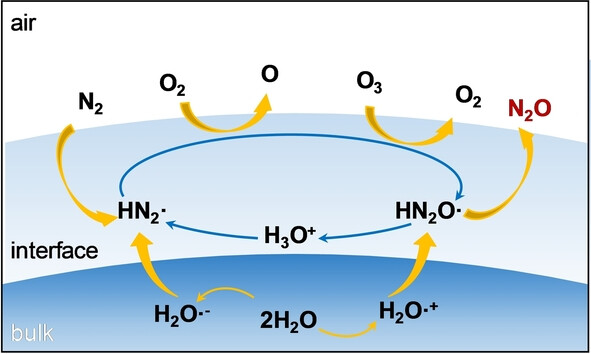
Nitrogen (N2) is regarded as a stable reservoir for the N element in the atmosphere. However, this study finds that the stable N2 can rapidly react with atmospheric oxygen and ozone on ubiquitous water droplet surfaces via a novel reduction-then-oxidation pathway, resulting in the formation of nitrous oxide – the third most impactful greenhouse gas.
Biokonjugation
Entschlüsselung der Polymer-Interaktionen in Biokonjugaten unterschiedlicher Architektur durch zeitaufgelöste limitierte Proteolyse mit massenspektrometrischer Analyse
- First Published: 09 January 2025
Coordination Polymers
Selenium-Substitution Strategy for Enhanced Mobility, Tunable Bandgap, and Improved Electrochemical Energy Storage in Semiconducting Conjugated Coordination Polymers
- First Published: 21 January 2025

Using a selenium-substitution strategy, a new selenium-based ligand, tetraseleno-hydroxyquinone (TSHQ), was synthesized, leading to the construction of a semiconducting three-dimensional Ag−Se coordination polymer (Ag4TSHQ). Ag4TSHQ shares the same topological structure as its sulfur counterpart, Ag4TTHQ, but exhibits superior charge mobility of approximately 350 cm2/V⋅s, which is twice that of Ag4TTHQ. Additionally, it demonstrates enhanced electrochemical energy storage capabilities. This research underscores the advantages of selenium-ligand-based coordination polymers (c-CPs) in optoelectronic devices and energy storage technologies.
Nanopore | Very Important Paper
Identification of Oligosaccharide Isomers Using Electrostatically Asymmetric OmpF Nanopore
- First Published: 24 January 2025
Polymer Chemistry | Very Important Paper
A Regio- and Stereoselective Ring-Opening Polymerization Approach to Isotactic Alternating Poly(lactic-co-glycolic acid) with Stereocomplexation
- First Published: 20 January 2025
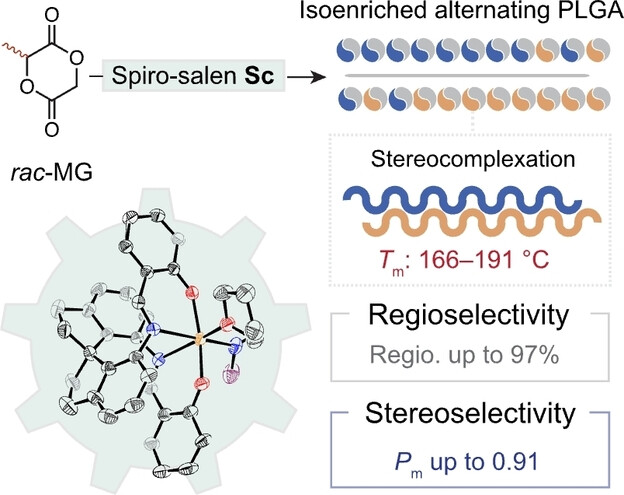
A robust regio- and stereoselective ROP approach was developed for the synthesis of isoenriched alt-PLGA (Regioselectivity up to 97 %, Pm up to 0.91) from rac-MG by the exploit of our spiro-salen scandium complexes, which represents a versatile platform for the preparation of high-performance biodegradable PLGA materials with diverse material properties and biodegradability.
Analytical Chemistry | Very Important Paper
Precise Identification of Native Peptides with Posttranslational Proline Hydroxylation by Nanopore
- First Published: 25 January 2025
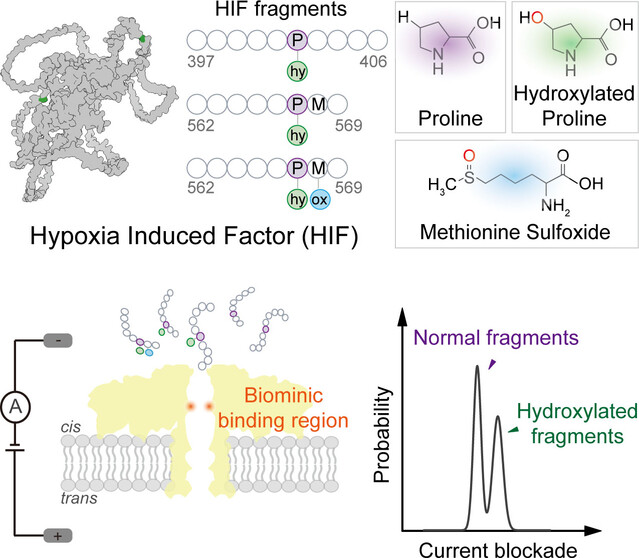
A rationally engineered nanopore was constructed to directly discriminate posttranslational proline hydroxylation in native peptides. By modeling the specific binding structure, hydrophobic region was introduced into aerolysin to transduce the hydrophobicity difference induced by hydroxylation. Precise identification of proline hydroxylation in hypoxia-induced factor protein was achieved without interference from adjacent oxidation.
Molecular Photoelectrocatalysis | Hot Paper
Unlocking HFIP for Fluoroalkylation with Molecular Photoelectrocatalysis
- First Published: 23 January 2025

Organofluorine compounds bearing the hexafluoroisopropyl group remain extremely scarce due to the lack of appropriate fluoroalkylation reagents. Herein we report a molecular photoelectrocatalysis method for the C−H hexafluoroisopropylation of indoles and tryptophan peptides, utilizing hexafluoro-2-propanol (HFIP) as the fluoroalkylation reagent.
Biocatalysis | Hot Paper
Enantioselective Trifluoromethylazidation of Styrenyl Olefins Catalyzed by an Engineered Nonheme Iron Enzyme
- First Published: 23 January 2025

A new-to-nature enzymatic platform for the enantioselective trifluoromethylazidation of alkenes has been successfully established. Through 11 rounds of directed evolution, an engineered variant of nonheme iron enzyme, BsQueD-CF3, was developed, enabling the production of a wide range of enantioenriched CF3-containing molecules. This platform based on metalloenzymes would open a new avenue for biocatalytic trifluoromethylation chemistry.
Heterotriangulenes | Hot Paper
A Trithia-Bridged N-Heterotriangulene: The Hitherto Missing Electron Donor
- First Published: 16 December 2024

An unprecedented triphenylamine with three sulfur ortho bridges has been developed as the very first representative of the hitherto elusive family of electron donors. The compound is readily oxidized to the corresponding radical cation with exceptional stability and forms crystalline donor-acceptor complexes with cyano-based acceptors.
Natural Products
Secupyritines A-C, Three Natural Propellane Securinega Alkaloids: Structure Elucidation and Total Synthesis Based on Biogenetic Building Blocks
- First Published: 03 January 2025

Three novel polycyclic pyridine alkaloids (1-3) featuring a unique 2-oxa-6-aza[4.4.3]propellane skeleton were discovered from the twigs and leaves of Flueggea suffruticosa. Guided by a synthesis strategy based on the biogenetic building blocks, the first total synthesis of 1-3 was achieved through vinylogous Mannich-type reaction, Suzuki coupling reaction, and intramolecular aza-Michael addition reaction as key steps.
C-H functionalization
Late-Stage Pd(II)-Catalyzed C(sp3)−H Functionalization of Peptides Directed by a Removable, Backbone-Inserted Amidoxime Ether
- First Published: 05 January 2025

A Pd-catalyzed C(sp3)−H arylation of peptides has been developed, directed by an amidoxime ether, which can be incorporated into peptides at any amide bond. The backbone-installed directing group facilitates site- and stereoselective arylation of peptides, including at internal residues. Removal of the amidoxime ether generates the parent amide enabling a traceless C−H functionalization process.
Genetic Code Expansion
Design of Cell-Penetrating Domain Antibodies via a Genetically Encoded β-Lactam Amino Acid
- First Published: 07 January 2025
Supramolecular Chemistry | Very Important Paper
Kinetic Control of Self-Assembly Pathway in Dual Dynamic Covalent Polymeric Systems
- First Published: 14 January 2025
Ferroelectric Perovskite | Hot Paper
Precise Tailoring of Unprecedent Layered Perovskite-Type Heterostructure Ferroelectric via Chemical Molecular Scissor
- First Published: 20 January 2025
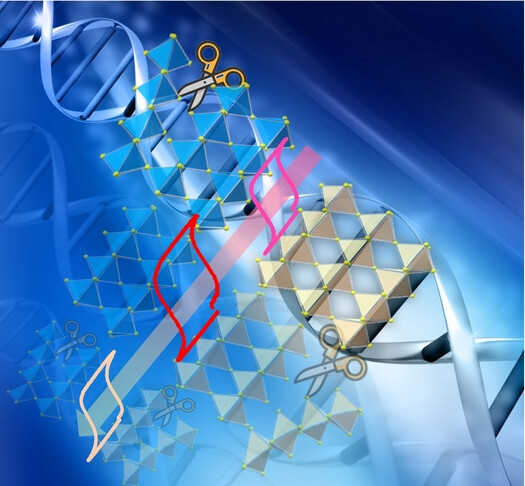
This work reports the first ferroelectric of 2D perovskite heterostructures as single crystal by precisely tailoring inorganic sheets via a chemical molecular scissor. Combining its strong ferroelectricity and inherent anisotropy, crystal-based device exhibits an ultrahigh polarized-light sensitivity up to ~37 in self-powered mode. This work will facilitate the further development of ferroelectric materials for optoelectronic device applications.
Organometallic Chemistry
The Interplay of Methylidyne and Carbido Species: Modeling a Fundamental Step in the Fischer–Tropsch Synthesis
- First Published: 20 January 2025
Anion Channels
Anion Transport by Bambusuril-Bile Acid Conjugates: Drastic Effect of the Cholesterol Content
- First Published: 10 January 2025
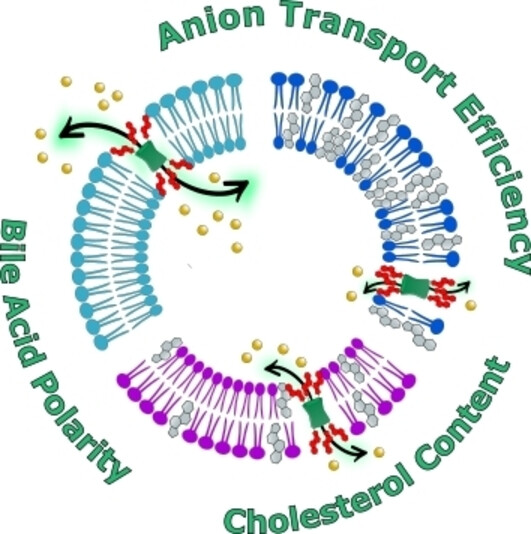
Bambusuril macrocycles were functionalized with bile acids of different polarities and studied as anion transporters. The bambusuril with the most polar bile acids was demonstrated to form a unimolecular anion channel. Furthermore, increasing the cholesterol content in the membrane of liposomes drastically decreased the ion transport activity, likely squeezing the bile acid arms together to close the channel.
Li–O2 Batteries | Very Important Paper
Machine Learning-Guided Modulation of Li+ Solvation Structures towards Optimal Electrolyte Systems for High-Performance Li−O2 Battery
- First Published: 26 January 2025
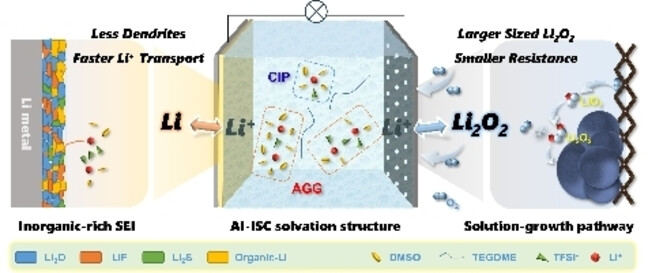
A dual-solvent electrolyte has been successfully developed by aid of machine learning, which can show anion-induced ion-solvent-coordinated structures. As a result, a stable inorganic-rich SEI could be formed on anode, while large sized Li2O2 particles on cathode by regulating the growth pathway, enabling exceptional Li−O2 battery performance. These findings highlight the critical role of solvation structures and provide valuable theoretical guidance for rational design of next-generation electrolyte systems.
Electrocatalysis | Hot Paper
Electrochemical Cyclopropanation of Unactivated Alkenes with Methylene Compounds
- First Published: 24 January 2025

A general and efficient method for the organo-mediated electrooxidative cyclopropanation of unactivated alkenes with methylene compounds has been developed. The method shows excellent functional group tolerance and a broad substrate scope that can be extended to late-stage modification of biorelevant compounds.
BERICHTIGUNG
BERICHTIGUNG: Correction to “Chiral Isochalcogenourea-Catalysed Enantioselective (4+2) Cycloadditions of Allenoates”
- First Published: 03 February 2025




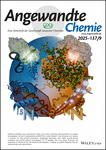

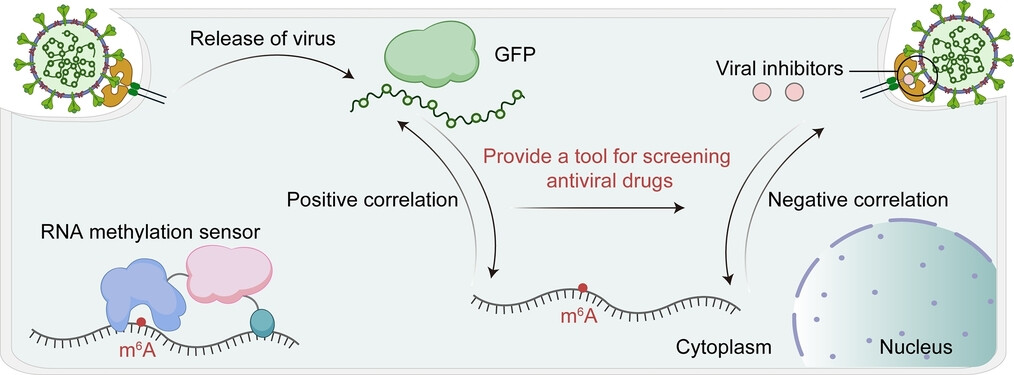
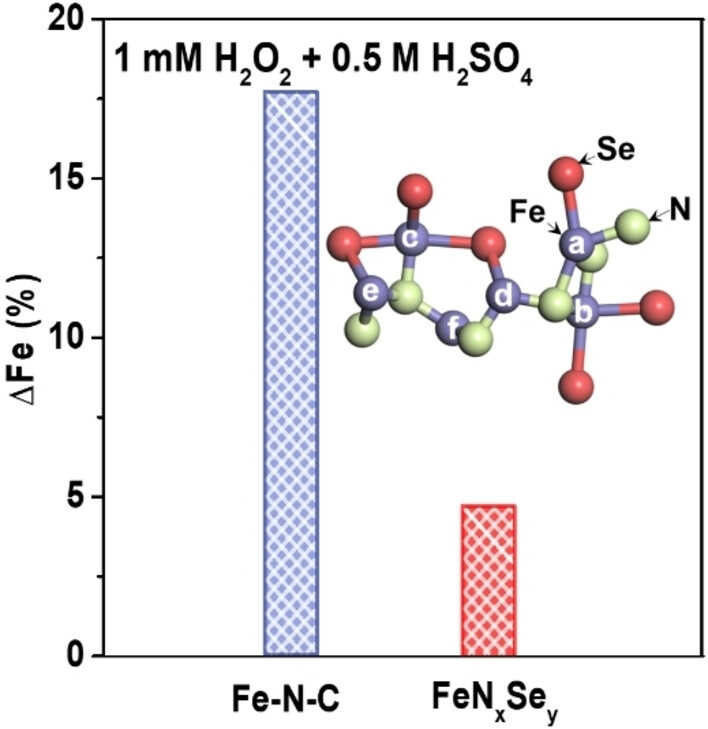
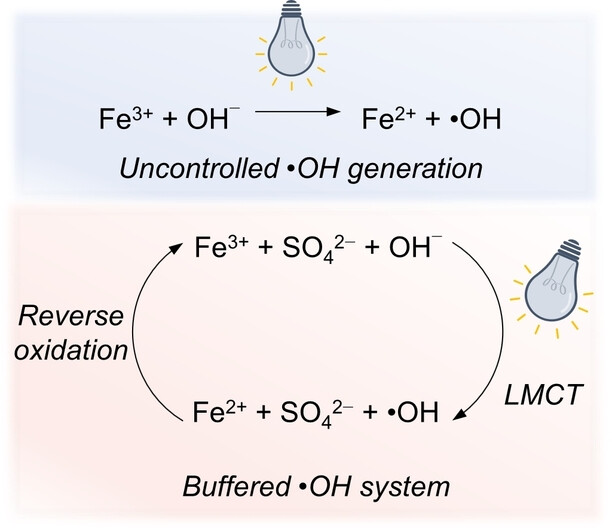
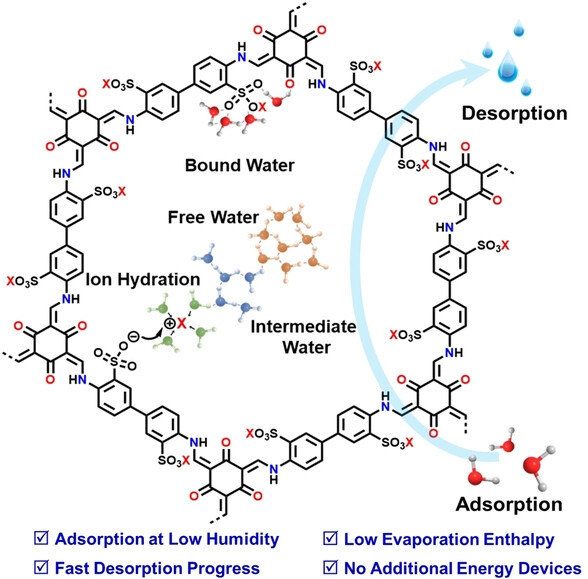
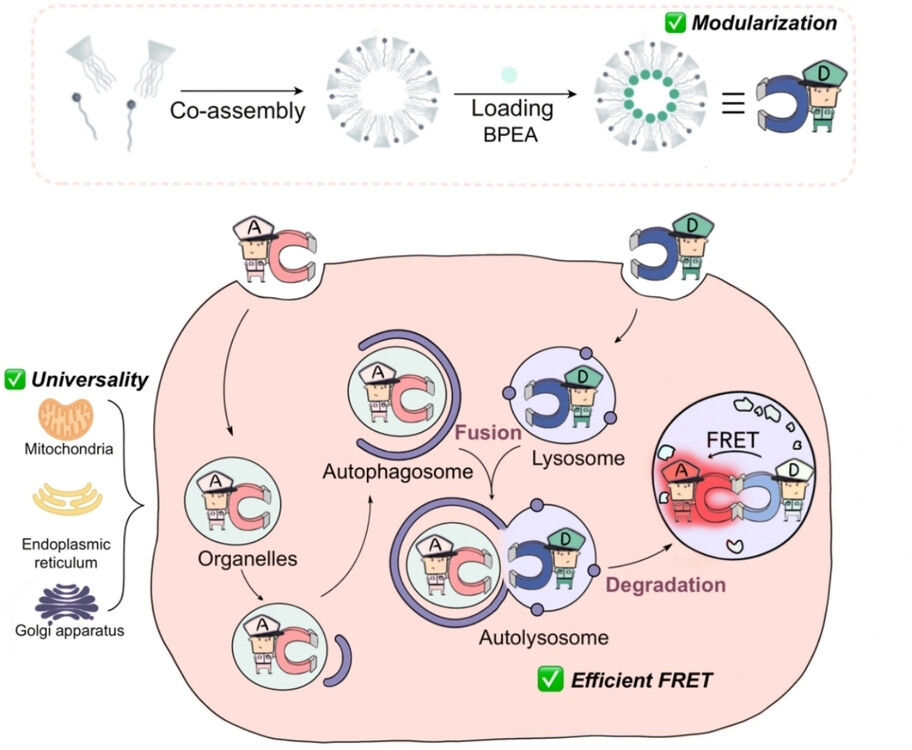
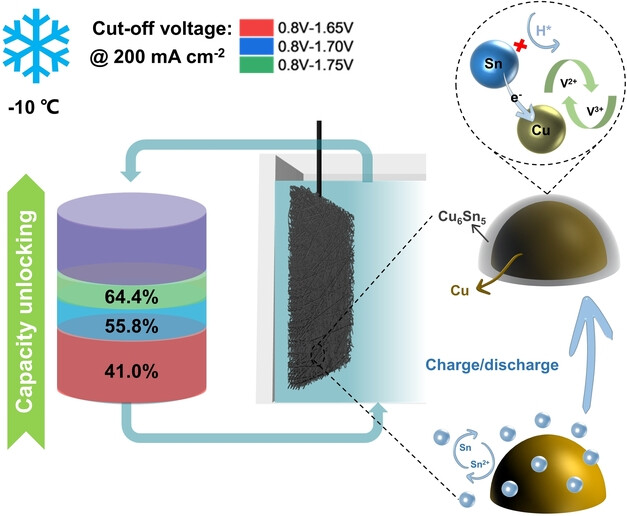
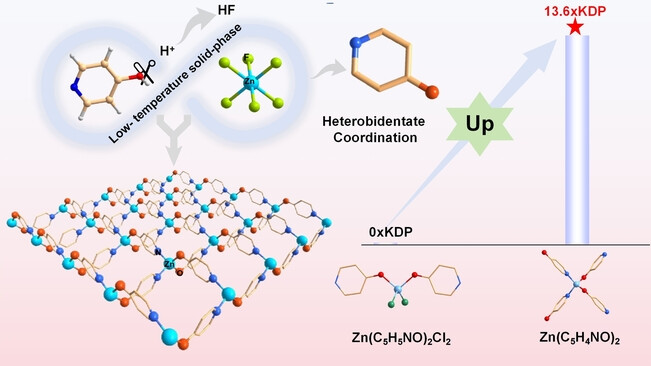
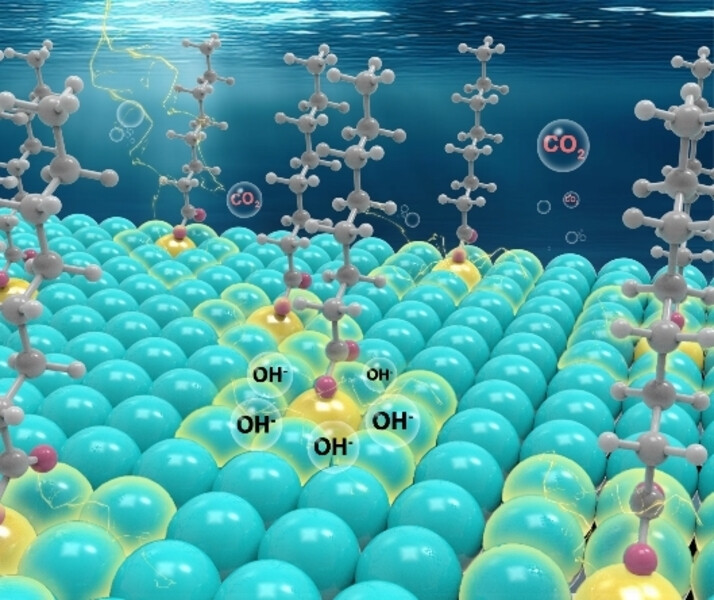
![Diverse Synthesis of Arene-Fused [n.1.1]-Bridged Molecules via Catalytic Cycloaddition and Rearrangement Reactions](/cms/asset/688c957f-b83d-4faa-bf97-e9db4da5735c/ange202420831-toc-0001-m.jpg)
